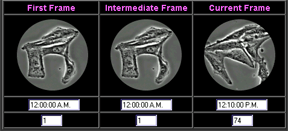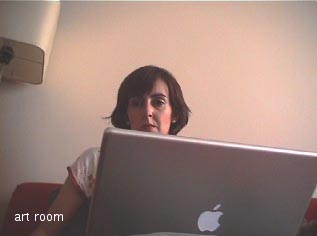« June 2005 | Main | August 2005 »
July 30, 2005
Why Bother
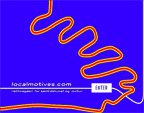
Live Video Streaming from Artists' Studios
During the autumn of 2005, Localmotives will be organizing a project which aims to stream live video imagery from several artists' working spaces (aka «studios»). The project is named Why Bother and will be produced in collaboration with i/o/lab and Atelier Nord. The video streams will be part of localmotives' 11th themed publication. The publication is titled 1:1 and will be physically manifested at Rogaland Art Centre (Rogaland Kunstsenter) from the 15th of September to the 27th of November.
We would like to get in touch with artists who already enjoy a high bandwidth connection to the internet, and would like to participate in Why Bother. You don't need to know a lot about video streaming. We will provide the technical assistance to make things work.
There are no million euro cheques to win here, but on the other hand you won't have to behave like an ass. We expect you to do the things you'd usually be doing, and you don't have to be in front of the camera all the time. It doesn't matter whether your working space is a desk, a corner of your livingroom or a good old studio.
We hope to gather participants from a geographic area as possible. The live streams from the various studios will be displayed in steady rotation on monitors in the exhibition room at Rogaland Art Centre.
Interested? Get in touch with: Geir Egil Bergjord, geiregil[at]localmotives.com (+47 51 89 33 39/+47 922 27 616) or Kevin Foust, kevin[at]iolab.no (+47 412 97 293)
_http://www.localmotives.com_
_http://www.iolab.no_
_http://www.anart.no_
Posted by jo at 09:21 AM | Comments (0)
July 29, 2005
Ecce Homology
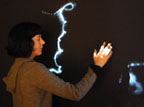
Can artistic approaches and aesthetic experience nurture discovery in the sciences?
Ecce Homology is an interactive installation that bridges art and science through the use of dynamic media, computer vision and computer graphics. Named after Friedrich Nietzsche’s Ecce Homo, a meditation on how one becomes what one is, the project explores human evolution by examining similarities – known as “homology” – between genes from human beings and a target organism, in this case the rice plant.
Experience Ecce Homology during SIGGRAPH 2005, July 31 - August 4, 2005 at the Los Angeles Convention Center. Five projectors present Ecce Homology’s calligraphic forms across a 40-foot wide wall. A novel computer-vision interface allows multiple participants, through their movement in the installation space, to draw their own calligraphic characters and select genes from the human genome for visualizing the Basic Local Alignment Search Tool (BLAST), a primary data-mining tool used worldwide in comparative genomics. Results are presented as two superimposed pictograms. Ecce Homology asks: Can artistic approaches and aesthetic experience nurture discovery in the sciences? Read an article.
Posted by jo at 09:53 AM | Comments (0)
New on AudioHyperspace

Two Way Radios [2WR]
"Each receiver a potential transmitter". It was not only Hans-Magnus Enzensberger who imagined radio as a two way medium: Brecht's dictum of "radio as an apparatus for communication" is more than famous. Freeing radio from its centralized and mono-directional broadcast structure has been a strong claim since radio's early days. And it has been especially the Internet, which made two way radio-structures become a serious possibility.
Based on the thoughts and utopies of Brecht, Enzensberger, but also on "La Radia" by F.T. Marinetti and Pino Masnata, the Belgian sound and media artist Guy van Belle created his series of performances Two Way Radios [2WR]. Premiered in Prague on April 14, 2005 this set-up of sound and communication architecture was performed in a new version on "Radio_Copernicus", a German-Polish artist radio on July 28, 2005. Several bi-directional audiostreams, generated by four performers (Guy van Belle and Barbara Huber in Stralsund, Akihiro Kubota in Tokyo, Code 31/Okno Brussels) were mutually altered within this group. [more]

Early Sonic Networker: Guy van Belle
"Sabine Breitsameter: Guy, you have been a sonic net artist long before the internet became popular for a general public. When was your first sound work you did with the net? When did you start?
Guy van Belle: I think the first time we used a network, which was already a TCP/IP network, was in 1992, and the reason why we did it was actually that I was part of a composers' band called "Young Farmers Claim Future". Basically we were two people, that was me and Herbert van de Sompel. He is now a researcher in Los Alamos. But he was working at a library as head of the automatization of library, and I was at that time working at an educational department, it was a research project about literature and technology from an educational background." Continue reading Early Sonic Networker: Guy van Belle in Conversation with Sabine Breitsameter.
Posted by jo at 08:33 AM | Comments (0)
Virtual Canoe
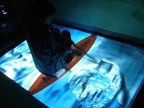
Rigid and Soft Bodies for Realistic Haptic Interaction
Virtual Canoe is a real-time water simulator with a database of 3D fluid dynamics. The system introduces realistic and interactive water into virtual worlds with haptic characteristics that enhance interaction.
The system combines a pre-computed database and a real-time simulation to establish a realistic waveform. The real-time component is a wave-function simulator that transmits water pressure and velocity. The database provides a force pattern for a point on an object's surface at a constant input velocity. The pressure from the database effects the velocity of the water in the real-time wave simulation, which keys the query to the database. This enables the system to create a realistic waveform. It carefully decomposes the original Navier-Stokes equation into a simple real-time function and a complex pre-computed function considering the area and the phenomena. Video. Virtual Canoe will be presented at the upcoming Siggraph conference. [blogged by Regine on we-make-money-not]
Posted by jo at 07:39 AM | Comments (0)
July 28, 2005
Human Scale Chess Game
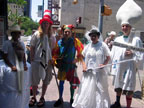
We Call Your Moves
Join the eighth Human Scale Chess Game in Oakland on Saturday, August 06. The organizers need 32 volunteers with working cellphones to play the roles of the chess pieces. Sign up now by email to select the role you will play. To participate, you will need a working cellphone and a couple of free hours on Saturday August 06. Costuming is strongly encouraged; the campier, the better.
SMS simulcasting and webcasting will likely be used during the Oakland game and there will be an afterparty. Check the site for updates as more details become available. Human Scale Chess is a project of Glowlab contributor Sharilyn Neidhardt. [via Glowlab]
Posted by jo at 04:44 PM | Comments (0)
A General Theory of Platforming
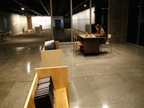
The Brand is Itself a Platform
"In the essay “The Poetics of the Open Work,” Umberto Eco details a postmodern phenomenon wherein performers are allowed judgment in the performance of a work. Rather than acting as merely talented automatons, the performers are “allowed” by the composer to change the fundamental material of the work as they perform it; they become the work. The usual power dynamic between composer and performer is changed. By inviting the performer into the process of composition, the composer becomes something closer to a platformist. What remains unchanged in this equation is the position of the audience, whom Eco calls that “addressee…bound to enter into an interplay of stimulus and response.” Participatory art brings the audience into the work, but might not address the position of the venue in how the work is conceived, crafted, and disseminated. In the art of platforming, composer, artist, and addressee determine the foundation and full realization of the work, changing the definition or specific role of each in the process. Traditional institutional power dynamics are upended and a multivalent balance is struck between each element in the equation of culture: the venue, the presented, and the audience." From A General Theory of Platforming by Nicholas Frank, NYFA Current.
Posted by jo at 09:20 AM | Comments (0)
intelligent agent Vol. 5 No. 1
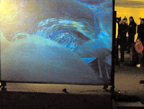
Artistic Virtual Environments, Aesthetics and Experiences
Guest Editor: Dena Elisabeth Eber, Artistic Virtual Environments, Aesthetics and Experiences: This special issue of Intelligent Agent presents six essays that explore the aesthetics connected with virtual environments created and presented as works of art, works about art, or related genres. The essays primarily focus on the aesthetic experience for participants, aesthetic analysis, content, emotional content, emotional experiences, and the qualities of the medium.
//artistic virtual environments//
Dena Eber, Greg Little, Brian Betz, "The Aesthetic Experience, Emotion and an Artistic Virtual Environment": Eber, Little, and Betz explore the aesthetic experience for participants interacting with artistic virtual environments (AVEs). Their essay presents aformal study that measures the experience through the emotional response of participants, which gauges the perceived emotional content of the AVE. The authors examine if this kind of content coupled with the immersive qualities of the AVE facilitates a rich aesthetic experience and thus a high feeling of presence for the participant.
Josephine Anstey, "Agents in Love. On the Construction and Use of Emotional Characters in VR": Anstey discusses her approach to interactive drama that provides an "emotional terrain" for the participants to discover. According to Anstey, emotional response is best elicited by employing two key components, the application of dramatic tools for narrative media to immersive virtual environments and the use of artificial intelligent agent-actors that guide participants. Anstey applies ideas similar to Alfred Hitchcock's psychological approach to a scripting process in which the theme centers on anxiety and emotional tension.
For a full Table of Contents, visit http://www.intelligentagent.com
This issue was made possible by funding from the New York State Council for the Arts, a state agency.
intelligent agent
Editor-in-Chief: Patrick Lichty
Director: Christiane Paul
http://www.intelligentagent.com
intelligent agent is a service organization and information provider dedicated to interpreting and promoting art that uses digital technologies for production and presentation.
Posted by jo at 09:08 AM | Comments (0)
July 27, 2005
The Upgrade! Montreal:
![]()
The In & Out of the Sound Studio Conference
Thursday, July 28 - 7pm - free: The Upgrade! Montreal presents the In & Out of the Sound Studio conference on gender and sound technology, in collaboration with Concordia University. Featuring performances by artists Sylvie Chénard, Ellen Waterman, Airi Yoshioka, Shona Dietz & Éveline Boudreau. With hosts Liselyn Adams & tobias c. van veen.
Posted by jo at 06:03 PM | Comments (0)
INDIA FOUNDATION FOR THE ARTS
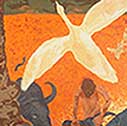
Grants for Indian New Performance Artists
New Performance Programme: Are you a performing artist or group? Are you seeking funds to develop an innovative new production in theatre, music, dance or other forms of performance art? If so, this programme is addressed to you. Please read on.
Scope: This programme supports exciting new productions in the performing arts. These productions could straddle different genres in the performing arts, explore multilingualism in performance, use new media innovatively, or address subjects that have not been widely explored in performance. These are only examples, however, and do not exhaust the possibilities offered by this programme.
Application: Applications under this programme can be submitted for consideration at any time. You may write your proposal in any Indian language including English. You can expect to receive a reply from us within one month, indicating whether your proposal falls within the programme's scope and budgetary limits.
To apply, please send us a short note describing:
a) Your existing practice, and your concerns and interests as a practitioner.
b) The nature of the production for which you are seeking funding and how it addresses our programme.
Please also remember to include the following with your proposal:
a) Reviews and recordings (if available) of your work.
b) Your bio-data or background information about your institution.
c) Your address, telephone/fax numbers, and e-mail address.
d) A work plan, specifying the duration of the project.
e) A budget.
You may also wish to include two references from senior artists in your field.
You may seek support to cover costs relating to the mounting of your production. These could go beyond technical production costs to include pre-production research and other costs. You can also include costs for the first performance of the production in your budget.
You are welcome to develop your proposal through dialogue and interaction with IFA staff. You may write to us or post an online letter of inquiry describing your project idea briefly. You may also use the online letter of inquiry to communicate with us on any matter pertaining to this programme.
Eligibility: You are eligible to apply if you are an Indian national, a registered non-profit Indian organization, or have been resident in India for at least five years. Your collaborators, if any, should also fall into one of the above categories.
Send your queries and proposals to: contactus[at]indiaifa.org or write to:
The Executive Director
India Foundation for the Arts
Tharangini, 12th Cross, Raj Mahal Vilas Extension
Bangalore - 560 080
Tel/fax: 080 - 2361-0584 / 2361-0583
www.indiaifa.org
Posted by jo at 02:29 PM | Comments (0)
Social Machines

Continuous Computing
"...After a decade of hype about "mobility," personal computing has finally and irreversibly cut its bonds to the desktop and has moved into devices we can carry everywhere. We're using this newly portable computing power to connect with others in ways no one predicted--and we won't be easily parted from our new tools...
There is something different about the latest tools. They are both digital, rooted in the world of electrons and bits, and fundamentally social, built to enable new kinds of interactions among people. Blogging, text messaging, photo sharing, and Web surfing from a smart phone are just the earliest examples. Almost below our mental radar, these technologies are ushering us into a world of what could be called continuous computing--continuous in the usual sense of "uninterrupted," but also in the sense that it's continuous with our lives, in all their messy, social, biographical richness..." From Social Machines by Wade Roush, Technology Review, August 2005.
Posted by jo at 11:01 AM | Comments (0)
Audio Signal Processing Workshop
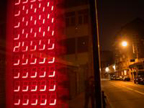
Audio Data, Synthesis, Patching & Streaming
Audio Signal Processing/Digital Sound Workshop: Rotterdam, 1 - 4 September 2005; Applications Deadline August 19, 2005--In a four-day workshop hosted by V2_, sound artists Frank Barknecht and Aymeric Mansoux will introduce the basics of Audio Signal Processing (ASP) in the fields of real-time music production. This workshop specifically targets people who want to develop their work in the digital sound field or those people curious about the processes involved behind the audio software they already use.
The program starts with a theoretical introduction to the basics of digital sound, after which participants will work with the open source software Pure Data (PD) to turn theory into practice. The workshop also teaches and demonstrates which free technologies are available for audio streaming, such as icecast, ogg and vorbis. A Rotterdam Headphone Lounge will wrap up this four-day workshop on Sunday 4 September.
SCHEDULE AUDIO SIGNAL PROCESSING WORKSHOP
Registration fee: euro60 (food & drinks included)
Reservations via v2@v2.nl
Location: V2_, Eendrachtsstraat 10, Rotterdam
URL: www.v2.nl
www.goto10.org
DAY 1 11:00-18:00 hrs // ASP and Audio Synthesis
A day with the blackboard: the physics of sound, the digital representation of sound, basic audio signal processing, synthesis, samples and soundfiles
DAY 2 11:00-18:00 hrs // Pure Data
Applied theory: messages versus audio signals, audio building blocks and operators, delay & filters, building an FM patch, a sample playing patch and an effect patch
DAY 3 11:00-18:00 hrs // Pure Data next level + streaming audio
how to do basic physical modelling, waveshaping and additive synthesis, introduction to audio streaming, presentation of: icecast, ogg, and vorbis, and building an audio streaming system
DAY 4 11:00-15:00 hrs // Patching and streaming
putting things together: working on a patch
20:00-23:00 hrs // Le Placard: Rotterdam Headphone Lounge
APPLICATION
WORKSHOP DATE: Thursday 1 - Sunday 4 September 2005, 11:00-18:00 hrs
HOST: V2_, Institute for the Unstable Media
LANGUAGE: English
FEE: 60 euros
LOCATION: V2_, Eendrachtsstsraat 10, Rotterdam
FOOD & DRINKS: free tea+coffee, lunch included
HOUSING: not included
HARDWARE: computers are provided
BOOKING: v2@v2.nl
DEADLINE FOR APPLICATIONS: Friday 19 August 2005
V2_, Institute for the Unstable Media
Eendrachtsstraat 10, 3012 XL Rotterdam, NL
PO Box 19049, 3001 BA Rotterdam, NL
Tel + 31 10 206 72 72 | Fax + 31 10 206 72 71
E-mail info AT v2.nl | URL http://www.v2.nl
Posted by jo at 10:50 AM | Comments (0)
Ambient Experience Suite
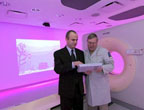
and Kitten Scanner
"The Ambient Experience suite uses Philips' lighting and consumer electronics to create a welcoming and patient-friendly environment for children undergoing medical scans. Featuring a Philips Brilliance CT (computed tomography) scanner in a room with curved walls, it lets young patients choose a theme - or 'ambient environment' - for the room by waving a radio frequency card over a reader to project cartoons and animation themes onto the walls and ceiling using Philips technology. They can also use the Kitten Scanner.
Designed specifically for children scheduled for a CT scan, the Kitten Scanner will let them 'scan' a stuffed elephant or their own toys at the touch of a button. Animation appears on a screen that shows children what doctors are looking for inside the toy and tells them a story about each one. The aim is to show them how the machine works and help ease any anxiety they may be feeling." (Via PhysOrg)
Posted by jo at 09:14 AM | Comments (0)
SCAN Volume 1 #3
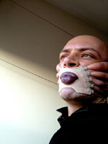
BODILY (Trans)Formations
BODILY (Trans)Formations :: Volume 1 Number 3 November 2004: " “[T]he body should be understood not as a constant amid flux but as an epitome of that flux” (Csordas 1999: 1-2).
This issue of Scan takes as its guiding principle the idea that bodies, far from being bounded and inert flesh-sacks from which each of us navigates and negotiates our way in the world, are kinaesthetic ‘inter-sites’ of (un)becoming. It is in and through the regulation and codification of ‘flesh’ that bodies come to matter, that subjectivities are formed and transformed. Of course, claims such as this are by no means new. In fact, in the context of post-structuralism, such claims have more or less become truisms. But simply proclaiming that bodily being is the dynamic effect of historically and culturally specific processes of inscription contributes little to our understanding of the complex heterogeneous ways in which bodies and selves are formed and transformed.
Likewise, the uncritical celebration of the alleged plasticity of bodies and selves all too often overlooks the necessity of engaging with the question of how, and to what extent, particular kinds of bodily practices performed in specific contexts may (and/or may not) challenge traditionalist accounts of the body as inert pre-determined matter.
The papers in this issue were chosen because each of them maps, in detail, a particular terrain of bodily (trans)formation, and each explores the relations between the (trans)formation of specific bodies of flesh, bodies of knowledge, institutional and social bodies. Dmitry Mikhel’s paper provides an account of a range of new cultural practices and modes of organisation in post-Soviet Russia and focuses in particular, on the ways in which these practices (and their histories) (re)inscribe the bodies of Russian citizens, positioning them in specific ways in relation to one another and to historico-political ideals. Nikki Sullivan’s work is an exercise in ethical problematization which takes as its focus the debates which are played out across - and which simultaneously constitute - the body of Michael Jackson. Paddy Hartley’s images and the somatic technologies pictured therein, blur the boundaries between enhancement and mutilation, reconstructive procedures and cosmetic practices, the marked and the unmarked, raising the question of the role such ontological categories play, and the effects they (re)produce. In “The Monster Body of Myra Hindley”, Cathy Hawkins explores cultural narratives of monstrosity particularly as they pertain to feminine embodiment, and the (en)gendering of criminality. Harminder Kaur’s “Producing Identity: Elective Amputation and Disability” examines the ways in which changing conceptions of self-demand amputation could be said to illuminate issues about bodily boundaries and the production of disability. Similarly, Margrit Shildrick’s paper challenges the normative characterisation of disabled bodies as necessarily non-sexual, arguing that in fact their very dis-organisation, and their necessarily overt contiguities with an array of others, better enables such figures to breach the boundaries and explore what lies beyond the normative limits. Petra Boynton’s work is also concerned with mapping the (trans)formation of sexual subjects. In her contribution to this collection, Boynton interrogates the marketing of sex drugs by big-pharma companies, the problems this poses to men and their partners, and asks what, if anything should be done about this. Robert Payne’s paper “Digital Memoires, Analogues of Affect”, engages with the interface between human and computer memory, in order to examine how the construction of memory in an online context could be said to flesh out the spectral, post-biological self, inscribed as a digital assemblage of context-specific contingencies. Drawing on a number of insights developed by Deleuze and Guattari, Greg Hainge reconfigures pain as in(ter)corporeal affect, as a positive accessory of desire, in and through which necessarily dis-organised bodies perform the work of (un)becoming. Lastly, Daniel Nourry’s paper critically engages with the complex anti-corporeal logic at the heart of Catholic subjectivity through an analysis of the crucifixion as narrative event.
Despite their seeming disparity, then, these papers each contribute to the claim that bodies are not neutral, natural, and unchanging objects, by offering detailed analyses of the many and varied practices and processes in and through which bodies - and by extension, selves - are formed and transfomed. In other words, the salient factor connecting them is a concern with the matter of body politics." Edited by Daniel Nourry & Nikki Sullivan.
Body Politics in Post-Soviet Russia by Dmitry Mikhel: This paper examines new cultural practices and modes of organization in post-Soviet Russia.
'It's as plain as the nose on his face': Michael Jackson, modificatory practices, and the question of ethics by Nikki Sullivan: This paper critically engages with the ways in which so-called cosmetic procedures and the subjects who undergoe them are problematized.
Fleshly Impressions: The Work of Paddy Hartley by Paddy Hartley: This series of works by Paddy Hartley explores the notion of impressionable flesh.
The Monster Body of Myra Hindley by Cathy Hawkins: This paper is an attempt to investigate the effects of cultural narratives of monstrosity.
Producing Identity: Elective Amputation and Disability by Harminder Dosanjh Kaur: This paper is concerned with a range of questions surrounding and informing current conceptions of and responses to self-demand amputation.
Queering Performativity: Disability After Deleuze by Margrit Shildrick: This paper sets out to elaborate an alternative framework for rethinking sexual subjectivity, and in particular its relation to notions of 'disability'.
Better dicks through drugs? The penis as a pharmaceutical target by Petra Boynton: This paper makes a critical intervention into the marketing, use, and effects of sex drugs.
Digital memories, analogues of affect by Robert Payne: This paper explores the role of memory in the constitution of identity.
“Pagan Poetry”, Piercing, Pain and the Politics of Becoming by Greg Hainge: This paper provides an account of the role of pain in the process of (un)becoming.
The Christological Imperative: notes towards a speculative re-interpretation of Catholic martyrdom by Daniel Nourry
Posted by jo at 08:53 AM | Comments (0)
Laurie Anderson: The Record of the Time

Sound in the Work of LAURIE ANDERSON
Laurie Anderson: The Record of the Time is a 30 year retrospective of Laurie Anderson's works that opened last week at the NTT InterCommunication Center [ICC], Tokyo. It will run through October 2, 2005.
Laurie Anderson (born 1947) rose to acclaim on the New York art scene of the early 1980s with her distinctive electronic performances, and continues to be a major globally active artist, one the very few truly international stars of performance art today. Utilizing synthesizers, video and computer graphics as well as various electronic devices of her own design, she blends diverse elements - music, moving images, language, action - into eclectic cocktails of experimental ideas and avant garde modes of expression that appeal to a broad popular audience. She is, in a word, the very embodiment of colorful postmodern performance.
Recently invited to become the first ever Artist-in-Residence at NASA, she created a new performance piece under their auspices. She is also currently showing an installation-video-performance work in a Japanese garden as part of Expo 2005 Aichi. Indeed, her keen creative energies seem inexhaustible.
The present exhibition was produced by the Musee d'Art Contemporain de Lyon, after which it toured to Dusseldorf, Milano and Dublin before coming here. Comprising some ninety pieces - everything from early works steeped in the conceptualism of the 1970s, to videos, assemblages, installations and original violins, to photos and drawings right up to projects for Expo 2005 Aichi - the exhibits span an artistic career of over thirty years, making this a real retrospective show, and for many of us here in Japan, a prime opportunity to take in the full scope of her multi-disciplinary, multi-media pursuits.
Posted by jo at 08:35 AM | Comments (0)
The Reentry Series

Synthetic Meteor Showers
The Reentry Series uses multiple synthetic meteors to produce luminous, ephemeral drawings in the upper atmosphere. These drawings will persist for only seconds, at most minutes. The behavior of individual synthetic meteors will be similar to that of naturally occurring meteors. However their composition and configuration will be controlled, exhibiting various elementary geometric relationships which will seem obviously premeditated and systematic to any observer. That these are deliberate renderings will be inescapable. The Reentry Series is one of several proposed series of dynamic environmental works which involve the synthesis and aestheticised use of otherwise naturally occurring, very large scale, time dependent visual phenomena.
The work explores the large scale use of the environment, and the atmosphere in particular, as a medium for visual composition. A consequence of the activity is to highlight the extent to which humankind has impacted and has control over the environment. The work mimics the naturally occurring phenomena of meteors, which have historically been attributed with significant religious or supernatural import as signs or omens and demonstrates that these events can now be synthesized and manipulated at will. It is land art on a mega scale, exposing the degree to which we have altered and have the ability to further modify our environment. The work combines elements and properties of technological, environmental, and conceptual art.
Posted by jo at 08:15 AM | Comments (0)
Cracks in the Pavement:
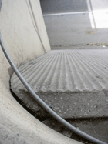
Gifts in the Urban Landscape
Cracks in the Pavement: Gifts in the Urban Landscape is a multi-phased, interactive project that calls attention to the “in-between” spaces encountered throughout everyday life. The project focuses on details within the urban landscape and encourages close inspection of our social space. This summer, artists based in locations around the world will respond to what they find in their urban environments by making art objects designed to be placed in sites that intrigue them—at bus shelters, in alleys, under bridges, in libraries or post offices, or deep in park bushes. Members of the public are invited to search for these site-specific works using maps and clues provided at the web site. Art works featured in Cracks in the Pavement may be kept by whoever finds them. Works not found will be allowed to remain in the landscape indefinitely to be encountered by chance, displaced, or transformed by the very environmental forces that define each piece's context.
The process of discovery lies at the heart of the project. It invites people to engage with their surroundings intimately, encouraging any number of potential encounters or experiences provided in the act of searching. Every environmental detail reveals evidence for an event occurring at a moment in time, as careless and forgettable as roadside trash thrown from a car window or as sublime as the cracks in a building’s foundation caused by an earthquake or tornado. Cracks in the Pavement asks us to ponder where we are in relation to what surrounds us. It calls attention to what we pass by every day, as well as what we leave behind.
Cracks in the Pavement was started in Austin, Texas, in June 2004. The project featured site-specific works by 15 Austin-based and international artists both in Austin and in London, UK and was presented as part of the London Biennale 2004. This year, the project will be launched in multiple phases in different locations throughout summer 2005; click here for a list of participating artists, locations and launch dates. Cracks in the Pavement is organized by Heather Johnson, and will be on view throughout the summer until the last piece is found.
Posted by jo at 07:58 AM | Comments (0)
July 26, 2005
Infomera.net

HTML Wrestling
"How did you come up with this idea? What was the concept behind this Infomera HTML Wrestling?
The idea was to create an ephemeral project for the Internet. The name of the website is the combination of to ideas "informacion" (Spanish: information) and "efimera" (Spanish: ephemeral; feminine version). I deal a lot with the isis and tropos process with objects and I was hoping to create a metaphor of this on the web.
Infomera.net is a process that happens on the web, two artists confront each other in a context elaborated as a metaphor within a specific period of time. Infomera.net is a conceptual performance/happening elaborated as a ludic expression that demonstrates the diffusion and execution of the technique between the confronting artists. It’s not really a fight; it’s more of a collective expression between two people, an event of user/artist expectations and unique situation's." From Ephemeral Angel: Arcangel Constantini, Wrestler, Artist, Curator, Petite Mort, Issue #3.
Posted by jo at 09:52 AM | Comments (0)
3 x 3
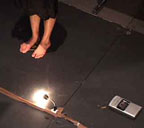
Looped
3 x 3--by Gemma Shusterman: the project looks at the fundamental relationship between audience and performer by putting the audience in the active role as collaborator rather than simply the passive role of observer. The performer becomes a conduit for a structure created by the audience. The audience in turn is given active involvement in creating their own experience and becomes engaged in an exchange with other audience members controlling the course of the piece.
The project consists of a web interface which allows the audience member to enter coordinates that map to the performer's space. These coordinates are then sent to a microcontroller (using the cockroach microcontroller) which controls the power supplied to the selected portions of the space. It is then the performer's job to find a way to move from one section of the space to another in improvisational form. The subsequent performance is then broadcast back to the site via webcam. video documentation. full video from live performance on 12.08.2004.
Posted by jo at 09:05 AM | Comments (0)
INTERNATIONAL PRIZE FOR PERFORMANCE:
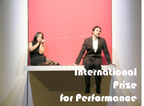
FINAL DAYS TO PARTICIPATE IN THE SELECTION!
These are the final days to submit an application for the first International Prize for Performance, a unique and innovative initiative, launched by the Galleria Civica di Arte Contemporanea of Trento (Italy), in collaboration with drodesera>centrale fies and with the support of the Fondazione Cassa di Risparmio di Trento e Rovereto.
Artists of all nationalities, thirty-five years or younger, can participate by completing the electronic application located on the Galleria Civica di Arte Contemporea of Trento’s website by August 1, 2005 (For more information, consult the official announcement at http://www.workartonline.net or send inquiries to performance[at]galleriacivica.it).
Award: 5,000 Euro and other minor prizes
Contact: Galleria Civica di Arte Contemporanea of Trento
Via Belenzani 46, 38100 Trento - Italy
http://www.workartonline.net
Phone +39 0461 985511
performance[at]galleriacivica.it
The internationally renowned jury includes the “Mother of all Performances” Marina Abramovic, Renato Barilli (art critic and performance expert), Mathias Lilienthal (Director of the Hebbel Theater, Berlin), Andrea Lissoni (Associazione Xing), Virgilio Sieni (Dance company Virgilio Sieni), Barbara Boninsegna (drodesera>centrale fies) and Fabio Cavallucci (Director of the Galleria Civica, Trento).
On September 9th and 10th, 2005, twelve (12) finalists will conduct live, unedited performances for the international jury at the Centrale di Fies (Dro, Trento). First place winner will chosen and awarded a prize of five-thousand (5,000) euro by the jury, who will also grant various minor prizes.
Submission Requirements and Deadline: All artists, of all nationalities and origins, from all backgrounds (visual arts, dance, theatre, music, poetry, etc.) thirty five years or younger, are invited to participate by completing the electronic application located on the Galleria Civica di Arte Contemporanea’s, website (http://www.workartonline.net directly send to performance@galleriacivica.it).
Participants are required to send: - a never-before-seen performance project (descriptive, no longer than 3,000 characters, spaces included) - an artistic resume; - a scan of a current identification document; - two to four excerpts from previous performances (in mpeg format, more or less one minute each).
Participants may also send descriptions of previous performances (no more than three of narrative character, no longer than 1500 characters each one), and images (no more than 10 total). Additionally, they may also send up to two reviews appearing in catalogues, magazines or newspapers.
The paper material must be written in either Italian or English languages.
The video material may be sent in diverse languages whenever the comprehension of discourses is not considered a necessary element in order to understand the sense of the performance.
Together all of the sent material must not exceed 4 megabites.
The expiration date for the application and materials is fixed at 5 PM on August 1st, 2005 (Italian time).
Note: The following people can not participate in the Prize: members of IPG (International Performance Group) and those that have a familiar relationship or are in strict collaboration with the members of the jury.
Finale and Awards
12 (twelve) finalists will be selected to present a performance on the evenings of September 9th and 10th, 2005 in the Centrale di Fies (Dro, Trento).
The participants in the final selection are guaranteed travel expenses and hospitality for the time needed to realize the performance in Trento. Production costs will be sustained directly by the organization. It will be an assessable element on the part of the jury in the selection phases, as well as the relationship between the final effect and the economic commitment required for the production of the performance. The specific request for actors or other possible personnel involved in the performance will be organized by the artist or group.
The first prize is fixed at 5,000 (five-thousand) euros (net) and can not be divided. There will also be minor prizes awarded.
For more information and registration, +39.0461.985511; performance@galleriacivica.it
Galleria Civica di Arte Contemporanea
Via Belenzani 46
38100 Trento, Italy
T: +39 0461 985511/986138
F: +39 0461 237033
E: galleria_civica@comune.trento.it
W: http://www.workartonline.net
Posted by jo at 08:40 AM | Comments (0)
Storied Theory
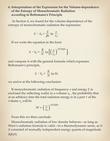
The Story Is in the Theory
"...All theories tell a story. They have a beginning, in which people and ideas, models, molecules and governing equations take the stage. Their roles are defined; there is a puzzle to solve. Einstein sets his characters into motion so ingeniously, using entropy to tease out the parallels between moving molecules and the energy of light. The story develops; there are consequences of Einstein's approach. And at the end, his view of light as quantized and particular confronts the reality of the heretofore unexplained photoelectric effect. The postscripted future, of all else that can be understood and all new things that can be made, is implicit.
Perceptive reader Anne Poduska notes that the photoelectric paper "is particularly interesting because of the layering of perspectives (similar to legends being passed from one generation to the next, with each storyteller adding their own flair/details)."..." From Storied Theory by Roald Hoffmann, American Scientist Online.
Posted by jo at 08:22 AM | Comments (0)
asemic

Text|Image
The word “asemic” means “having no semantic content”. Illegible writing or pretend writing could be described as asemic. When we can’t read something which appears to be writing, other possibilities occur. Perhaps we can see a picture instead. Sometimes we can “read” the emotional state of the person who made the asemic writing. Or we can decide that it looks Chinese, or Hebrew, or Indian, or like alien writing.
People from all parts of the world produce asemic writing. They range from poets to calligraphers to visual artists to children to doodlers. Asemic magazine is the only publication specifically devoted to this area. Back issues can be downloaded free. Issue 1 Issue 2 [PDF] [blogged by Wilfried Hou Je Bekon at socialfiction.org]
Posted by jo at 07:50 AM | Comments (0)
Emotive Virtual Actors
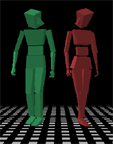
Man looks at audience for 2 secs...
Emotive Virtual Actors by Ken Perlin:
INSTRUCTIONS: Using the mouse: Drag hands and feet with the left mouse button to move arms and legs + Drag with the right mouse button to change the view + Click/drag on any button, menu or slider + With "walk" enabled, click on destination to walk there + Click on "F1" or "F2" to select an actor.
THINGS TO TRY: Pull the hand away from the body to see torso compliance + Try lifting up a foot and watch him shift his weight. Then try putting the foot down again + Click on the "object" option, and watch how he holds an object as you drag his two hands around. You might want to turn on the "closeup" option to see this better...
Posted by jo at 07:44 AM | Comments (0)
DNA11

The Pattern You See in our Art Comes from [the Real] You
DNA11 creates unique DNA portraits through an extraordinary combination of science and art. The process begins with the DNA being collected using a patented, non-invasive technique: depositing your saliva into a tube. This sample is then sent to our highly secure, certified laboratory, where the DNA is extracted to create a unique genetic fingerprint, using a technique that takes advantage of the variation that occurs among the DNA sequence of every individual.
The end result is a group of different sized pieces of DNA (unique per individual), which we "run" on a gel, such that each strand of different sized DNA is separate...The DNA is then stained with a fluorescent dye and illuminated by UV light, which then glows, giving off a fluorescent signal.
A special camera captures the image which is then digitally enhanced, cropped, color adjusted, adding colors and filter effects.
Each piece is carefully processed to ensure the highest level of quality, and is then printed as a Giclee fine art piece. The art is made using high quality acid free polyester-cotton canvas, using pigmented inks designed to resist fading. It is then sealed with a non-yellowing protective varnish to further prolong the print life.
Each piece is then visually inspected and signed in the back by the artists at DNA 11, ensuring authenticity. The result is a high-end piece of art that can never be replicated, and is as unique as you are - no two pieces will ever be the same. When asked “who is the artist?” the answer is simple: you are. We take your life code and create a one-of-a-kind art piece, but the uniqueness is yours alone.
Each DNA 11 art piece is 100% unique. No two pieces will ever look the same, (unless you are an identical twin.) and the pattern you see in our art comes from you.
Whether you are purchasing a DNA 11 art piece for your home or office, for yourself, a friend or loved one including your children, for a special occasion or for your own personal pleasure, you will be purchasing a truly one-of-a-kind work of art that is the ultimate conversation piece for any modern art lover.
Beyond creating beautiful art, our mission is to bring the power and mystery of DNA out of the labs and into people’s lives. As well, our mission is to help others by contributing a portion of every sale to charity.
See examples of size and color options here
Learn more about our creation process works and learn more about our product
Explore our gallery to see real-life examples of our finished and framed art
Purchase your own DNA art here. [via]
Posted by jo at 07:30 AM | Comments (0)
Kobito:
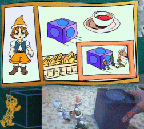
Virtual Brownies
You wake up in the morning and sit at your breakfast table. There comes a can of Earl Grey, magically sliding towards you. But, who's suggesting to have a cup of tea? A group of students at Tokyo Institute of Technology created an installation called "Kobito: Virtual Brownies," which allows us to see and feel who it is: kobitos (dwarves).
The system was developed using Computer Vision, Artificial Intelligence and Haptic Feedback technologies. The dwarves appear in a movable display device called Kobito Window (see below) that blends video images and virtual 3D avatars of dwarves. Kobito Window is like a magic lens through which people can view the world differently from the way our naked eyes can see: the device recognizes its orientation using a rotary encoder and displays 3D avatars based on a current view angle. Moreover, you can feel the dwarves through haptic feedback. If you hold the tea can, you can feel the force of the dwarves. If you push the can against the dwarves, they will react to it.
This mpeg movie shows the overview of the system with English captions.
Kobito will also be showcased at SIGGRAPH 2005 which will soon take place at Los Angeles Convention Center (July 31 - August 4). A description of their installation can be found here.
The camera mounted on the ceiling tracks the position and the orientation of the tea can. Based on this tracking technology, the software application determines how 3D avatars act. The system presents the 3D avatars visually (in Kobito Window) and physically (on the table as movements of the tea can). The tea can is controlled by a mechanical component hidden under the table (see the above photo). This component, whose position can be programmatically controlled, integrates a magnet for moving the metal can without physical contact.
People who created this installation think systems like this "can be used in the fields of design, amusement, and healthcare."
More video clips:
Kids playing with Kobito1
Kids playing with Kobito2
Related Website: Robot Technology Research Forum at Tokyo Institute of Technology (in Japanese) [blogged by manekineko at we-make-money-not]
Posted by jo at 07:15 AM | Comments (0)
The Underbelt

The Stay Slim "Tug"
The Underbelt--by Cristina Bilsland--is a piece of underwear. This self-operated constricting device provides a physical reminder of satiety whenever required. As soon as a button is pressed, the belt pulls itself inwards, giving the wearer a brief "tug" around the waist to give the body a physical reminder of satiety. It then releases to a comfortable fitted position. This piece challenges our awareness of guilt towards gluttony through physical constriction. Science has proven that tightness around the waist plays a major role in our behaviour towards food consumption. Ironically, clothing manufacturers continue to silently and gradually increase actual fitting dimensions whilst continuing to use existing size labels. This piece raises the question whether we are subliminally buying into this self-delusion. It also aims to question how far we are prepared to go in our indulgent quick-fix culture. [for entire "Fat" post see we-make-money-not]
Posted by jo at 07:05 AM | Comments (0)
Drawn
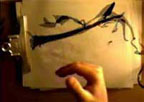
Drawn to Perform
Drawn--by Zachary Lieberman and Pardon Kimura--is a concert-performance in which live painting is augmented in real time, the painted forms appear to come to life. The performance explores the musicality of drawing by turning brushstrokes of ink into complex and energetic life forms.
A table on stage holds the paper, ink and brushes. A camera above the table captures the drawing and the image is then projected for the audience to observe. However, the projected image is not entirely unadulterated - a software analyses the video image and augments the image with synthetic graphics. The result is a hybrid video signal, combining both factual and fictional pixels. The hand-drawn gestures appear to have a mind of their own: they can be played with as though they weren’t actually painted on paper, and the user can push them around the page using only his hands.
One of the main concerns of the developers was to create a visual "instrument" that could be used in collaboration together with musicians. In this nuanced relationship between animated drawing and sound, the sketches, doodles, and gestures mix together with the sonic environment in order to create a dense and lively musical form. The videos on the website are really impressive. [blogged by Regine on we-make-money-not]
Posted by jo at 07:00 AM | Comments (0)
July 25, 2005
History of Networked Art:
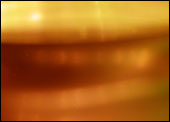
People, Places, Events, Technologies and Theories
History of Networked Art: People, Places, Events, Technologies and Theories--a conference curated by Tommaso Tozzi and Alessandro Ludovico; Friday, July 29, 2005; 9.30am - 1.30pm / 3pm - 7pm; Accademia di Belle Arti (Academy of Fine Arts) Via Roma 1 - Carrara (Tuscany, Italy) tel. +39 0585 71658.
In the networked art the artwork's boundaries dissolve in the intertwined relationships between subjects, objects, strategies and theories. This process not only modifies artistic, political and commercial models, but it transforms the culture, the languages and the logic behind the theories of the interconnected society. Inter-disciplinarity, indetermination, transformation, decentralization and interaction, are among the key concepts of the sixties. But they are also the background of the artists that have used the telematic networks to plan new worlds or to critique the existing ones. The conference 'History of the Net Arts' has the purpose to gather some important experiences about some of the most active subjects, their actions and external collaboration with institutions, groups and movements, the technologies they used and, even more importantly, their theorical, social and cultural goals.
with (in alphabetical order):
Robert Adrian (Wien, AU)
Hans Bernhard (Wien, AU)
Arturo Di Corinto (Roma, IT)
Steven Kovats (Rotterdam, NL)
Enrico Pedrini (Genova, IT)
Cornelia Sollfrank (Hamburg, DE)
Luca Toschi (Firenze, IT)
installation:
Giuseppe Chiari (Firenze - IT)
"Audio and Video recording from the seventies and eighties"
program:
9.30am - 1:30 pm
- Tommaso Tozzi - coordinator of Multimedia Art
Department, Academy of Fine Arts Carrara,
Florence, IT
- Enrico Pedrini - critic, Genova, IT
- Luca Toschi - director of the Communication
Strategies laboratory and head of the
Communication Theory master's degreee, Florence,
IT
- Robert Adrian - artist - Wien, AT
- Arturo Di Corinto - teacher of Online Communication Psichology - Rome - IT
- discussion
3.00pm - 7:00pm
- Alessandro Ludovico - new media critic, Neural.it - Bari, IT
- Hans Bernhard - artist, Ubermorgen, Etoyholding - Wien, AT
- Steven Kovats - international programs
developer, V2_Institute for the Unstable Media -
Rotterdam, NL
- Cornelia Sollfrank - artist, Old Boys Network - Hamburg, DE
- discussion
Biographies.
Robert Adrian X (CA/AT) Celebrated contemporary artist, produces installations, radio art and sound art works from 1957, and he's one of the recognized pioneer of telecomunication art. He started to work and experiment in this field already in 1979. He lives in Vienna.
Hans Bernhard (CH/AU) One of the Etoy founders and creator of practices like the 'digital hijack'. He founded the Ubermorgen group with Lizvlx, and realized famous net.art works like 'Vote-Auction', 'Injunction Generator' and 'Google Will Eat Itself'. He won many awards like the prestigious Prix Ars Electronica's 'golden nica'. He lives and works in St.Moritz and Vienna.
Giuseppe Chiari (IT) Musician and artist. He's a composer from 1950 and he's the most important Italian representative of the Fluxus movement, and one of the most important italian artists of the 20th century. He wrote books, essays and writings that have changed the music system, and his works are exhibited in museums all around the world. He's author of happenings and music experiments and he wrote music for different media.
Arturo Di Corinto (IT) Cognitive psychologist and new media expert. Researcher at the University of Stanford (1997-1998), teacher at the Carrara Academy of Arts and University of Rome. He's author of essays on the technological innovation and social behaviours relationship. He's a founding member of the Avvisi Ai Naviganti BBS, Isole nella Rete and Cittadigitali. He also writes for the national newspapers Il Manifesto, La Repubblica and for the magazine Aprile.
Stephen Kovats (CA/NL) Canadian born architect and media researcher Stephen Kovats spent a decade upon German unification designing and establishing media art and culture related programs at the Bauhaus Dessau Foundation. His "Studio Electronic Media Interpretation" hosted numerous international projects, symposia and exhibitions. Kovats founded several media culture oriented exchange and network programs including Archi-Tonomy, EMARE, ECX and the Bauhauskolleg. Editor of the book "Media Revolution. Electronic Media in the Transformation Process of Eastern and Central Europe". Currently Kovats is international programs developer at V2_Institute for the Unstable Media in Rotterdam.
Alessandro Ludovico (IT) Media critic and editor in chief of Neural magazine from 1993. He has written media culture books and essays. He's one of the founding contributor of the Nettime community and one of the founders of the 'Mag.Net (European Cultural Publishers)' organization. He writes for various international magazines and he's also an expert in the Runme.org board and a collaborator of the Digitalkraft exhibitions.
Enrico Pedrini (IT) He curated international exhibitions and he was one of the curators of the Taiwan Pavillion in the 1995 Venice Biennale. He has written many essays on contemporary art. Actually he's studying the interactions amongst the Dissipative Systems, the Theory of Chaos and the Possible Worlds that bring to the art universe the cathegories of the dissipation and possibilism.
Cornelia Sollfrank (DE) Studied Fine Arts in Munich and Hamburg, taught at the Hochschule f�r Bildende K�nste, Hamburg, founder member of the female artists' group �Frauen und Technik� and '-Innen'. She's a founder-member of �Old Boys Network� and facilitator of the conference series 'Next Cyberfeminist International'. She works in the field of Internet art. She lives in Hamburg and Berlin.
Luca Toschi (IT) Director of the 'Laboratory of the communication strategies' and head of the master's degree in Communication Theory, University of Florence. Author of the book 'Il linguaggio dei nuovi media', he has written essays on the relationship between education and the language of new media. Ha has started his career as researcher in 1970 at the UCLA, during the establishment of the first Arpanet nodes. He's a consultant for private and public firms.
Tommaso Tozzi (IT) Teacher at the University of Florence and at the Carrara Academy of Arts, where he coordinates the Multimedia Arts Department. Director of uCAN - Center for Research and Documentation on Networked Arts and Digital Cultures. He has been the head of the cultural association Strano Network. Editor of Hacker Art BBS (1990) and creator of the first worldwide netstrike (1995). Founding member of the italian newsgroup Cyberpunk (1991) and of the net Cybernet (1993).
--
Alessandro Ludovico
Neural.it - http://neural.it/ daily updated news + reviews
English.Neural.it - http://english.neural.it/
Neural printed magazine - http://neural.it/n/nultimoe.htm
Posted by jo at 06:07 PM | Comments (0)
Fragmented Places and Open Societies
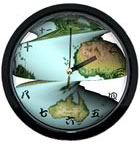
Space as the Material Basis of Time-Sharing
"Human life unfolds simultaneously in three environments, biological, built, and informational. Analytically, they can be distinguished, but in practice they are inseparable. The way we construct our houses reflects as much our bodily as our cultural determination. The relationship among these environments, however, is unstable. They mirror and penetrate each other in historically specific ways. Much of the turmoil of our present period can be understood in terms of a realignment of these three environments, driven by a profound expansion of our cultural capacities as information technology is expanding into an all-connecting internet. In the following, I will to look at how physical space is affected by this process and the challenges this poses to the future of society as an open political system." From Fragmented Places and Open Societies by Felix Stalder, NOEMA. [This essay was written for the catalogue of the exhibition “Open Nature”, ICC Tokio, April 29 - July 3, 2005]
Posted by jo at 03:58 PM | Comments (0)
Haptic Spaces
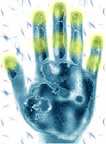
The Philosophical and Psychological Relation Between Touch and Space
"Touch and digital performance: This examines the expressive possibility of digital media performances that involve technologies of touch. This analysis includes examples of artworks divided into three separate 'moments' - the 'skin' and the discourse of surface; the 'flesh' and the notion of technological extension and prosthesis; and the 'body' and its motility, the way interactive touch is performed both on stage and online.
In digital performance some interesting developments have occurred whereby the body becomes displaced, and the senses distorted. This refashioning of the body in digital space has implications for theories of embodiment and of body morphology. Some digital performances positively engage in Luce Irigaray's (1993) discourse of fluidity in its evocation of the virtual environment, even the way the body navigates and moves around the virtual world, not by mastering space but by being penetrated by it." Continue reading >>. From Haptic Spaces by Mark Paterson.
Posted by jo at 12:10 PM | Comments (0)
Cancer Cell Cam
Cancer Cell Cam: Human Melanoma Cells Growing in Culture
Posted by jo at 12:05 PM | Comments (0)
@ SIGGRAPH 2005

ART & THE NETWORK SPACE over Access Grid
There will be a presentation on ART & THE NETWORK SPACE over Access Grid organized for Siggraph on August 4 at 17:30 London time. The panel will consist of Woody Vasulka at the ZKM in Karlsruhe, Jon Ippolito at the University of Maine, Mathias Fuchs and Don Foresta at the Wimbledon School of Art and Pavel Smetana, director of CIANT, present at Siggraph.
The discussion will center on issues of the network as an art space, specifically, questions of archiving and accessibility of work and integrating it into a larger academic context. The discussion will last for one and a half hours. The projects discussed will be:
1. MARCEL
2. ALTERNE
3. Variable Media
4. OASIS
5. Global Threads
If you are interested in the discussion, please let me know and I will put you in contact with the appropriate people. There are a limited number of online slots available at Siggraph and you would have to be registered before to receive it.
Best, Don
Don Foresta
27, rue du Rhin
75019 Paris, Fr.
Tel. 33 (0)1 4245 3186
don[at]donforesta.net
www.mmmarcel.org
Posted by jo at 11:58 AM | Comments (0)
Information Rain

It's Quite Natural...
"Researchers are working on "information rain", taking advertisements to the realm of mock meteorology. A projector on a tall tripod shows images of raindrops hitting the ground and making ripples, in hopes that people will enter the "rainy" area and hold out their palms.
A camera tracks the entrants' movements and sends the data to connected computers. Then the projector shoots out a round-shaped advertisement -- which can post words such as "SALE" -- right onto their hands. NTT Cyber Solution Laboratories, run by telecom giant Nippon Telegraph and Telephone (NTT) in the port city of Yokosuka south of Tokyo, believes the "rain" can be a perfect draw for customers.
"It's quite natural that you hold out your palm when it starts raining," said Yoko Ishii, a chief researcher in the human interaction project." Continue >> [via]
Posted by jo at 10:52 AM | Comments (0)
The Archer's Flight

City of IF
"I just finished reading a fantasy novella titled The Archer’s Flight. As the book’s introduction notes, it was the result of an unusual process:
It was serialized, appearing in seventeen chapters over a year’s time, but that’s not what’s unusual about it. It was published on the Web, but that’s not the unusual part either. What is unusual (and as far as I know, unique) is that this story’s readers chose the actions of its main character. Each published chapter ended in some dilemma for the protagonist, Deica; the audience collectively decided what she would do (via posting and voting on a web site), and their decision led to the next chapter. This was not a group of writers offering advice on what would make the best story; rather, the readers took on Deica’s role, as they would in improvisational theater or a roleplaying-type game. They decided what they would do if they were her.
Mark Keavney is both the author of The Archer’s Flight and the originator of the method used for its creation. He calls this method “storygaming” and describes it in detail in his essay “The City of IF Story.”" [blogged by noah on grand text auto]
Posted by jo at 10:36 AM | Comments (0)
Radio Forest
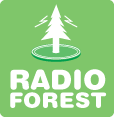
Sonic Wanders
The content on Radio Forest is made up of music and sound donated from the people of Neerpelt and surrounding areas, including; LP’s from personal collections, stories, lore, and sound produced during workshops at Musica. Portable radio’s will be available to check out at the Radio Forest cabin so that visitors can have a sonic wander through the forest.” The project is commissioned by Musica in Neerpelt, Belgium and a collaboration between artists Stijn Schiffeleers and Amy Franceschini as a sound project in reaction to this space."Upon their first visit to Music in December 2004, Amy and Stijn’s first impression was the roaring sound coming from the freeway passing through the forest. It was such a dominant sound factor, that they proposed to broadcast forest sounds from within the forest to the cars passing by on the freeway.” So driving by the forest will let you tune into forest sounds and avoid the technological distraction of your engine’s hum. [blogged by Jonah on coin-op]
Posted by jo at 10:02 AM | Comments (0)
Mediated Spaces

When Space Understands and Participates
"...The emerging relationship between people and pervasive computation is sometimes idealized as a "smart space": the seamless integration of people, computation, and physical reality. This paper focuses on a particular kind of smart space, the "mediated space," in which the space understands and participates in multiperson interaction. Mediated spaces will expand human capability by providing information management within a context associated with that space. The context will be created by recording interaction within the space and by importing information from the outside. Individuals will interact with the space explicitly in order to retrieve and analyze the information it contains, and implicitly by adding to the context through their speech and gesture. Achieving the vision of mediated spaces will require progress in both behind-the-scenes technology (how devices coordinate their activities) and at-the-interface technology (how the space presents itself to people, and how the space deals with multiperson interaction). This paper explores the research challenges in both of these areas, examining the behind-the-scenes requirements of device or manifestation description and context maintenance, as well as the interface problems of metaphor and understanding natural human-to-human spoken interaction." From Turning Pervasive Computing into Mediated Spaces by W. Mark, IBM Systems Journal.
Posted by jo at 09:51 AM | Comments (0)
SMS Satyagraha
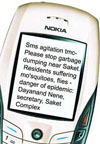
Systematic Non-Violent Resistance
For the uninitiated - Satyagraha is a philosophy of non-violent resistance against injustice, popularized by Mahatma Gandhi. The recently launched Mumbai Mirror tells a tale of how the Thane Municipal Corporation is being bombarded by text messages from 627 families of Saket Complex, a society of buildings, complaining and urging action against the stench created by open garbage. So much so, that the Municipal Corporation has had to change some of their officials' cell phone numbers! (read on for more details SMS Satyagraha!)
So intense was the onslaught that began on the morning of July 19 that the TMC changed some of its officials' cell numbers.Not to be outdone, the protestors took just two days to get hold of the new numbers and unleashed a fresh flurry of messages. While Day 1 saw over 300 SMSes beeping on hapless TMC officials' mobile phones, they are still receiving a 100 odd messages every day.
A brainwave of event manager and Saket Complex resident, Dayanand Nene, the protest is gradually showing results with TMC health department covering the garbage with sand to beat the stench. The residents, clearly unimpressed, say the SMS assault will continue. "In my profession, SMS is the ultimate way to reach out to the people. I realised that if we send SMSes to civic officials, they would have no option but to look into our problem," Nene said. Before they turned their cell phones into weapons, the residents of Saket Complex had tried everything from petitioning TMC officials to dharnas to get rid of the garbage dump. "For the past 25 days the TMC has been dumping garbage here. [Posted by Dina Mehta on worldchanging)
Posted by jo at 09:27 AM | Comments (0)
July 22, 2005
KODAMA
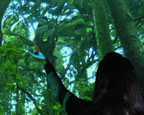
Whispering Trees
KODAMA (echo in English)--by Hisako Kroiden Yamakawa--aims at demonstrating the existence of voice as a physical object and how it floats through space. KODAMA are tree fairies that hide in the forest and listen quietly to your voice. They collect the voices and trap them in a bubble of air. When KODAMA don't sense the presence of humans they start playing with the voices that have been left in the forest. But as soon as they do notice someone they hide themselves with the "voice" and wait to collect new "voices". [blogged by Regine on we-make-money-not]
Posted by jo at 02:01 PM | Comments (0)
L.A.S.Y.

Live Action Scotland Yard
Live Action Scotland Yard (L.A.S.Y.) is a game created by Canadian designer Joel Friesen. The scenario is pretty simple: a ‘Mr X’ dresses in a bright yellow t-shirt, and then takes to the public transport systems of Toronto, Canada, pursued by three more people, ‘detectives’, in red shirts. The ‘criminal’ has to give clues to those chasing every third stop he makes.
One guy named Mr. X runs around Toronto’s transit system in a bright yellow shirt, while three or more guys in red shirts try to find him using the clues he gives at every third stop he makes. The three detectives are coordinated by dispatchers who tell the detectives where they think Mr. X might be and how best to block him off. Mr.X’s dispatcher is relaying information about the detectives whereabouts and tries to keep him away from them. The game ends when a time limit has been reached or X is caught. You need:
* A fully charged Cell phone with unlimited weekend minutes
* A Monthly or Day Pass for the TTC
* Sunscreen
Here are the rules: Scotland Yard is played by 6 or more people, half of the players are in the field, and the other half are dispatchers. Teams are paired up, one dispatcher with a field agent. Each pair is in contact with each other using a cell phone. One agent in the field is chosen to be “Mr. X” while the rest are detectives.(…) More about the rules here. [blogged by nicolas on pasta and vinegar]
Posted by jo at 10:10 AM | Comments (0)
Tai-Chi

Tangible-Acoustic Embodiment
Tangible Acoustic Interfaces for Computer-Human Interaction (Tai-Chi) explores how physical objects, augmented surfaces and spaces can be transformed into tangible-acoustic embodiments of natural seamless unrestricted interfaces. The ultimate goal is to design Tangible Acoustic Interfaces (TAI) that employ physical objects and space as media to bridge the gap between the virtual and physical worlds and to make information accessible through large size touchable objects as well as through ambient media.
The method that will be developed is based on the principle that interacting with a physical object modifies its surface acoustic patterns, due for instance to the generation of acoustic vibrations (passive method) or the absorption of acoustic energy (active method) at the points of contact. By visualising and characterising such acoustic patterns, it will be possible to transform almost anything (for example, a wall, window, table top or arbitrary 3D object) into an interactive interface (a giant flat or 3D touch screen), opening up new modes of computer-user interaction for responsive environments.
Because of their numerous advantages over other methods, including the spatial freedom they provide to the user, the robustness with which they can be constructed and the ease of accommodating multiple users simultaneously, acoustics-based interfaces will become a major sensing paradigm in the future, implying enormous potential for the whole computer and information industry. [via]
Posted by jo at 10:07 AM | Comments (0)
Golden Numbers
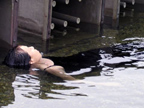
with Red Symbol
Golden Numbers--by Park Lee Chang Shik--is a sound installation that uses the gigantic speakers that were formerly used at the DMZ (demilitarized zone on the border between North and South Korea) for broadcasting propaganda. In this installation, the numbers from 0 to 36525 are read out. This number represents the number of days in the hundred years from August 15, 1945 to August 15, 2045. Further, recordings of old radio broadcasts and sounds produced in real-time from encoded signals are heard intermittently, and the audience can also use a microphone to broadcast their own voices through the speakers.
All these sounds mingle slowly around a circle, resembling the movement of a clock's hand or the orbit of a celestial body, and allude to the passage of time and history. The voices recorded into the microphone show that everyone lives within the flow of time, and contributes to history in some way. [via]
Posted by jo at 09:44 AM | Comments (0)
Autonomous Expressionism and Network Arts:
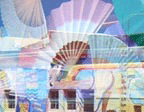
New Paradigms in Art, Emotional Interaction, and Information Retrieval
"Abstract: In this dissertation, I depart from traditional computer science metrics and methodologies and introduce a new framework for building computer systems with an emphasis on the creation of new artistic installations and interactions. Specifically, I introduce Autonomous Expressionism, an extension of Abstract Expressionism, whose goal optimizes the emotional experience in human computer interaction. I exemplify Autonomous Expressionism through the creation of several installations which externalize the World Wide Web as a repository of cultural connections; this is Network Arts. Each installation uses media...as a source and directs a performance using salient images and text found via web search. Together, the development of Autonomous Expressionism and Network Arts provides several advancements in Information Retrieval and Interaction Design. Additionally, I sub-classify types of Media Arts installations, which provides a framework for their comparison. Finally, I look towards the integration of Autonomous Expressionism in product design and software interaction." From Autonomous Expressionism and Network Arts: New Paradigms in Art, Emotional Interaction, and Information Retrieval, by David Ayman Shamma, Northwestern University [via]
Posted by jo at 09:41 AM | Comments (0)
Mollycoddle

Reciprocal Relationships
With Mollycoddle, Christine Liu wanted to explore the relationship that people have with their clothes. Mollycoddle is a dress with a hunger for love and attention. Its wearer needs the dress for obvious (coverage) or nonobvious (personal) reasons, and in turn, the dress needs the wearer. Mollycoddle wants to be touched and caressed by the wearer on a semi-regular basis, but it can be happy being touched by other people, too.
The dress is sort of an externalisation of the wearer's need for affection and attention. If the dress doesnt get touched or hugged in a while, it gets lonely, and the same goes for the wearer.
If the dress doesnt get loved enough, it gets needier and starts squeezing the wearer, begging for a touch or two. It will send vibrations as well. First it's a little huggy-plead which gets more aggressive with time. If its begging is ignored the thing will squeeze you to, ostensibly, death.
Christine Liu explained that "the touch part works, the squeeze part is still ongoing. i would like to have a corset-like frame in there to do that, but for the current prototype i have some naggy pager motors in there for vibrations along the kidneys and a tie-around necklace with its ends connected to some motors for squeezes around the neck. i didnt want to kill anyone in the construction of this thing, so i'm treading carefully." [blogged by Regine on we-make-money-not]
Posted by jo at 07:06 AM | Comments (0)
July 19, 2005
From Image to Interface:
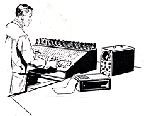
Preemptive Media
"The Preemptive Media Collective (PM) reengineers your thinking about mobile digital technologies imbedded in everyday environments. In live performances and real time actions, the PM art, technology and activist collective disturbs, dislodges, and redesigns new media technologies that we often ignore, like the bar codes on driver's licenses or radio frequency information devices used for EZ pass on highways...
At the forefront of what is called locative media, Preemptive Media repositions highly specialized technologies within the democratic discourse of low-tech amateurism. The emerging locative media movement has gathered steam and attention since 9/11 and the 2001 Patriot Act, which authorizes unprecedented data mining, invasions of privacy, wiretapping, and internet surveillance." Read From Image to Interface: Preemptive Media by Patricia R. Zimmermann, MediaChannel.org, July 8, 2005.
Posted by jo at 07:28 AM | Comments (0)
Maywa Denki in Paris
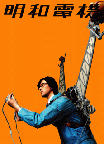
NAKI, TSUKUBA, and EDELWEISS
Maywa Denki is performing at Quartier d'ete Festival in Paris on July 21,22 and 23. This art unit, which is produced by Nobumichi Tosa, has been inventing a number of hard-to-describe electric devices by transforming the history and culture of small electrics manufacturers in Japan's high-growth period (about 40 years ago) into three product lines of interactive art objects: NAKI, TSUKUBA, and EDELWEISS.
They've "manufactured" various kinds of musical instruments including Pachimoku, which Nobumichi Tosa wears in the photo, and Koi-Beat, which could be interpreted as "love beat" as well as "carp beat."
Pachimoku is operated by finger snapping motion, which is sensed and transmitted to beater bars of the two Mokugyo's (wodden drums used in Zen rituals) at the top, through rather thick wires, which would withstand high voltage (e.g., AC 100 Volts, commonly used for home appliances in Japan).
Koi-beat (see this page) is a carp-shaped rhythm machine with 16x4 monotonous square electric switches and it generates groovy rhythms at 100 Volts.
They play music with the various instruments they've invented – You'll see if you get a chance to go to that event in Paris. For the rest of us, hopefully they'll record the event and turn it into another "manufactured product" of theirs (in short, a CD or a DVD). [blogged by manekineko on we-make-money-not]
Posted by jo at 07:23 AM | Comments (0)
Artphone at PROG:ME
For the first edition of prog:ME, the new media festival in Rio de Janeiro (Brazil), Susana Mendes Silva has developed a new version of Artphone, this time using Skype. [related]
Posted by jo at 07:09 AM | Comments (0)
AURAL AND VISUAL CULTURES AT GOLDSMITHS
NEW MASTERS DEGREE
NEW MASTERS DEGREE (MA) at Goldsmiths College (1 year full-time or 2 years part-time): This challenging new programme offers a unique opportunity to explore the ways in which different types of attention to music, phonography, broadcasting, the voice, telephony and noise have radically changed our understandings of visual and spatial cultures.The programme is set within the broader context of Visual Culture, and provides preparation for higher research in this area.
This inspiring new degree course is led by Kodwo Eshun, cultural critic and author of the acclaimed More Brilliant Than The Sun: Adventures in Sonic Fiction. Teaching involves seminars, lectures, debates, workshops and group projects. Guest lecturers for 2005-6 include Kaffe Matthews, Paul D. Miller aka DJ Spooky, Christian Marclay and Jem Finer.
The Department of Visual Cultures also offers: Postgraduate Diploma in Contemporary Art History, MA in Contemporary Art Theory, MRes in History of Art, and MPhil and PhD.
CONTACT
email admissions@gold.ac.uk
email k.eshun@gold.ac.uk
email kodwoeshun@blueyonder.co.uk
Admissions Office
Goldsmiths College
University Of London
New Cross, London
SE14 6NW
Tel 020 7919 7060
Posted by jo at 07:00 AM | Comments (0)
July 18, 2005
Op Art + DualView LCD

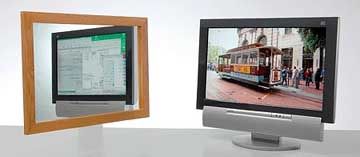
Optical Art or Op Art (1950's to 1960's) is a mathematically-themed form of Abstract art, which uses repetition of simple forms and colors to create vibrating effects, moiré patterns, foreground-background confusion, an exaggerated sense of depth, and other visual effects.
In a sense, all painting is based on tricks of visual perception: manipulating rules of perspective to give the illusion of three-dimensional space, mixing colors to create the impression of light and shadow, and so on. With Optical Art, the rules that the viewer's eye uses to try to make sense of a visual image are themselves the "subject" of the artwork.
Sharp has fused 2 LCD screens into 1 with its DualView LCD technology. The image changes depending on the viewing angle – bringing back sweet memories when Collectible Comic Trading Cards inserted a more primitive version in their sets as a rare bonus. Notice the mirror image in the picture on the left is different from what is shown. Simply amazing, I cannot wait to see what happens when such technology is implemented in desktops and notebooks in the near future!
Posted by jo at 10:44 AM | Comments (0)
Book Radio

Frequency Flipping
Vinat Venkatraman and Pei Yu's Book Radio takes the mental model of a physical book where user can browse by flipping pages, read by keeping a page open, and create a reminder of a specific page by placing a bookmark.
Each page of the Book Radio represents a frequency. You flip pages to scan the frequency spectrum; open to a specific page to listen to a station; place the bookmark on a desired page to listen and store the station; and slide the bookmark up or down to control the volume. Besides you can scribble in it, place stickers or take notes while listening. Videos. [blogged by Regine on we-make-money-not]
Posted by jo at 10:35 AM | Comments (0)
Rocketboom: Daily with Amanda Congdon
Rocketboom is a three minute daily videoblog based in New York City. We cover and create a wide range of information and commentary from top news stories to quirky internet culture. Agenda includes releasing each new clip at 9am EST, Monday through Friday. With a heavy emphasis on international arts, technology and weblog drama, Rocketboom is presented via online video and widely distributed through RSS.
We differ from a regular TV program in many important ways. Instead of costing millions of dollars to produce, Rocketboom is created with a consumer-level video camera, a laptop, two lights and a map with no additional overhead or costs. Also, Rocketboom is distributed online, all around the world and on demand, and thus has a much larger potential audience than any TV broadcast. However, we spend $0 on promotion, relying entirely on word-of-mouth, and close to $0 on distribution because bandwidth costs and space are so inexpensive. While TV programs have traditionally been uni-directional, Rocketboom engages its international audience in a wide range of topical discussions.
Posted by jo at 09:51 AM | Comments (0)
Talkaoke

Streamed, Spontaneous Chat with Real People!
Talkaoke consists of a doughnut shaped mobile table, hosted by a man in the middle with a microphone. Up to twelve people can sit around the table. Talkaoke is an active means of participation that is totally dependent on the context in which it is performed. There is no fixed agenda or expected outcome. Conversations are recorded for the on-line archive and can be webcast live. The people speak at Talkaoke.
Talkaoke is the brainchild of artist Michael (Mikey) Weinkove. Mikey had been working on video installations and live pieces constucting real and fictitious conversations. These were shown in UK and European galleries. In January 1997 Mikey was invited to create a one off performance at the Hydra Club, a live art club in London's East End. Mikey created Talkaoke, which was a scaled down version of a performance called "It's your shout!"
This was a previous performance with 100 invited people attending a forum with audience driven subjects and discussion. The Talkaoke format was so popular that it soon became a regular feature at Hydra.
In 1998 Talkaoke became part of the Duckie crew at their then upmarket Friday night West End club, Duckie Dancehall, where Denise joins the Talkaoke crew. Talkaoke became part of the furniture there too, and by spring Talkaoke had chewed the fat at a few of london's more leftfield clubs. In August Talkaoke did it's first festival gig at Summer Rites, a gay and lesbian festival in Brockwell Park. It was crazy stuff.
chat is the new rock n' roll
By the end of the year the Talkaoke team had given up fighting the deafening noise, late nights and intoxication of the clubs and began experimenting with a series of Talkaoke-with-accompanying-DJ-type events. The first was in winter '98 with a shortlived sunday residency at the Bug Bar, then in 99 at the Shoreditch Electricity Showrooms and the Crowbar. '99 saw Talkaoke at a number of underground parties too.
Although Talkaoke has had a website since '98 it was only when James Stevens of Radiospace witnessed Talkaoke at a party that the webcasting potential of Talkaoke was realised. The first Talkaoke streamed live by Radiospace was in April 2000 from Coffee@ Brick Lane. Webcasting rapidly became a successful Talkaoke feature. Talkaoke was invited by the Pleasance Theatre to perform at the Edinburgh Fringe Festival, where all the gigs were webcast.
like a chat room but in real life
This was the beginning of the format we see in public Talkaokes today with many behind the scenes technical developments: 2 mics, speakers in a battery powered table, video projection, web streaming, Djs providing background music. Talkaoke is seen mostly at festivals and the studio sunday sessions but who knows where we will be invited next?
Posted by jo at 08:45 AM | Comments (0)
AUD-802

Mode of Movement or Moved Object?
AUD-802 project is drawn around the issue of mobility, mainly materialized today by the automobile. It is built in the form of a series of stops. At each of these stops we question the city, its background and landscape.
AUD-802 is composed of three parts: AUD-802 [étape Anvers], an inflatable structure (representing at scale 1/1 a car, the license plate of which has become the project title); AUD-802 [étape Bruxelles], installations realised for each stop; and AUD-802 [déviation Blois], a website that is also the fixing point of this touring project.
"The exhibition proposed at la Maison de la Villette is presented as being the Launch of the Project AUD-802. It initiates the beginning of a route, starting in the green of the Parc de la Villette, which will be constituted by stages during which the overview of the car object (realized by an inflatable structure) will permit the constitution of a memory stored on the web site.
This exhibition consists of the Web site, which moreover allows the guests to adjust the sound atmosphere of the place, of the car object suspended in space and of video images where it becomes alternately toy, bait, monument or landscape. It also appears as a skin which is inflated, deflated, stored and put away. Contrary to the reality to which this object sends us back, it is no longer the mode of movement but the moved object." Joël Audebert and Nathalie Brevet_Hughes Rochette.
Posted by jo at 08:42 AM | Comments (0)
InteractiveSpaces.net
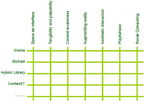
Concepts for Future Interactive Spaces
InteractiveSpaces is an interdisciplinary research center bringing together architecture, engineering, and computer science with the research mission to create new concepts for future interactive spaces. InteractiveSpaces.net also bring together companies and public researchers in a R&D activities leading to new products and services for specific domains. Research themes include:
Space as Interface: Through the emergence of pervasive computing our surrounding space contains both physical and virtual proporties. Interacting with these environments require a new way of understanding the relation between space and technology. To us interactions should not only be limited to simple displays but be a part of and take place in the space, and in that way using the space as the interface. This is done by combining the spatial and technological properties with the user as an interacting device – speaking to, gesturing with, moving in and touching the surrounding space. That way our interactions with technology gets a closer relation to the environments they are applied to.
Tangibility and palpability
The current focus on invisible computing and ambient intelligence does not take into account that users need to understand their environment and wish to be in control of the situation. To achieve comprehension and control we develop tangible and palpable environments. Tangible and palpable environments share similarities with pervasive and ubiquitous computing environments in that they consist of configurations of a number of components running on different devices in ephemeral interaction to serve certain purposes in a given context #lang sætning. However, tangible and palpable interactive spaces are different in that they are not based on the assumptions that computing is invisible, autonomous, and intelligent on behalf of its users. Instead we strive to create ready-to-hand understandable, visible and tangible services integrated in interactive spaces. We augment spaces such that they respect the qualities of the physical world.
Context aware interaction
We create seamless access to information and services in spaces without cumbersome logon and user interfaces that adapt to users based on e.g. location and profiles. We make the environments that carry user files and store information produced by users based on the context rather than try to let the users carry all their data on portables and the like. Computing support is called context aware, when the available services and information are provided based on a sense of the context, i.e. the time of day, the weather, the light, the user’s location, tasks, preferences etc. Context may be sensed by tracking the location of users and objects and by retrieving status, profile, or preference information from users’ active badges, PDAs or mobile phones. Services in an environment use the context-awareness to adapt functionality and user-interfaces of services to the context. The environments we develop will take advantage of context awareness and provide the users with relevant services.
Augmenting reality
The focus is on seamless augmentation of the physical environment with digital information and services without spoiling the affordances of the physical artefacts and the environment. Techniques include tagging and labelling the physical world with RFID or visual markers to link to digital information. Digital information may be superimposed on real world objects with different techniques, such as project or see-through displays.
Aesthetic interaction
The typical image of computers is closely related to grey boxes on our desktops. owever, as technology moves beyond the work environment into the domestic and cultural realms of life, the roles and ideals of information technology must reflect the experiential aspects of life. Through designing for aesthetic interaction we wish to make technology serve and enrich people's everyday life. Aesthetic interaction emphasizes a focus beyond functionality of computational devices taking departure in the more subtle and poetic sides of life. It aims for creating involvement, experience, surprise and serendipity in interaction with everyday artifacts and interactive spaces.
Aesthetic interaction
The typical image of computers is closely related to grey boxes on our desktops. owever, as technology moves beyond the work environment into the domestic and cultural realms of life, the roles and ideals of information technology must reflect the experiential aspects of life. Through designing for aesthetic interaction we wish to make technology serve and enrich people's everyday life. Aesthetic interaction emphasizes a focus beyond functionality of computational devices taking departure in the more subtle and poetic sides of life. It aims for creating involvement, experience, surprise and serendipity in interaction with everyday artifacts and interactive spaces.
Playfulness
A playful approach enhances people’s imaginary resources enabling new ways of perceiving and adopting the surrounding world. In our research playfulness is considered to reach beyond a temporary amusing activity; play is characterised as a voluntary, structured, purposeful and pleasurable activity involving the imaginary. It challenges and transcends established paradigms and ideas, and shares aspects of informal learning. The ambition is to design playful IT enhanced environments and artefacts that will enable new ways of seeing and support the person engaging with a system to take initiative and challenge its rules and conceptions.
Social Computing
Computing potentials are moving beyond the office into the spatial context of homes, institutions and the urban environment. Traditionally computers and artefacts have been designed for the individual user. However, the migration of technology towards a social environment, stresses the need for focusing on the use of technology in a social and spatial context. Taking point of departure in domestic and public contexts, interactivespaces design environments supporting social interactions, e.g. sharing information and knowledge and establishing new relations and contacts.
Posted by jo at 08:40 AM | Comments (0)
July 15, 2005
MIX-m.org
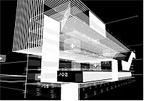
Material and Non-Material Space
MIX-m.org--by fabric | ch--is a mixed space architecture that exists at the same time in variable and complementary spaces: physical space (Contemporary Art Centre Geneva), digital space (a multi-users and game like environment), networked spaces (distributed over the internet). MIX-m.org exists at different scales. Its actual scale depends on the one set as "real" by each user (1:x, 1:50, 1:1, 50:1, x:1). It is basically a 2d-3d architecture project, both real and digital.
Oscillating and hesitating between black and white, between 2d and 3d, MIX-m.org museum echoes some historical archetypes: the "white cube" of modern museum as well as the "black box" of video-art installations. It also echoes some historical "special effects" environments (Tron, before post-processing).
Translated into "screen based" or "beamer based" architecture, this white to black condition becomes an over- to under- enlightened situation. Far from a functional intention, it proposes an evolving illumination system connected to the global activity of MIX-m.org server (rate of information). This system exists both in physical (neon light) and digital spaces (virtual light beam). MIX-m.org as mixed museum becomes therefore a variation between architectural types and references, playing with the user's eye and cultural habits.
Before creating MIX-m.org (3d environments, spatial presence, mobility and lighting concepts, web site), fabric | ch has been exploring contemporary space, within its material and non-material dimensions. The "multiplying space" concept, which underlies MIX-m.org, is the result of such experimental and then applied works: _knowscape mobile (2003-2005), map_I.T. for Swiss Fedral Insitute of Technology (EPFL, 2003) and in particular other "museum" projects, like La_Fabrique (1999-2001), a "3d chat" museum for Canal+, or electroscape 002 (2002), a prototype of MIX-m.org created for MAMCO and Version biennial. See also RealRoom(s).
Posted by jo at 06:25 PM | Comments (0)
Art_room

"An Artist in the Chat Room" by Luís Silva
"In 2002, Susana Mendes Silva (1972) put up, for Free Manifesta, the Artphone project, a cell phone mediated performance in which everyone could contact the artist, through her personal cell phone number, and discuss contemporary art related subjects. The slogan she used when advertising the project was revealing of what her purpose was: “Don’t be afraid to ask everything you always wanted to know about contemporary art”. Everything one has always wanted to know about contemporary art was available, only one phone call away. The artist exposed herself. Not only was she completely available for anyone who called but also assumed she could answer any question addressed to her.
In 2005, three years later, the cell phone was replaced. Instead of just being available, of waiting a phone call, the artist became more dynamic, active. She replaced the cell phone by an online video chat room and created Art_room, an online performance where anyone could meet the artist and, once again, ask her everything they wanted to now about contemporary art.
Besides the notorious change of environment and, consequently, the kind of relationships established, the artist also worked the engagement of those assisting or participating in the performance. It was mandatory to have an internet connection, to know the implicit rules of online chatting and to download different plug-ins that allowed the access and interaction in such an environment.
The performance was announced by email and happened in predefined schedules during the month of June. The goal was to put together, in the same place, the typical users of such chat rooms and people more familiarised with the contemporary art discourse. The development of the action taking place was let to chance and it would be completely dependent on the public and the artist’s interactions. Only one person other than the usual chatters of the chosen room showed up. The performance started and the artist introduced herself and told people to ask her questions about art. People in the chat room didn’t quite understand the objective of her behaviour and started to act aggressively towards her. As she repeatedly stated she was doing a performance and she wanted people to ask her questions about art, aggressiveness escalated and she was invited to leave the chat room, since her presence wasn’t welcome there.
The following day the artist repeated the performance in the same chat room. Everyone in the room were regular users and they were mostly present at the previous day actions. The artist continued her activity, seen as unwelcome and undesirable by some of the members of the room. Later on, the room monitor shut down her webcam and finally banned her from the monitored area, known as friends and family.
The Art_room project thus exceeded the artist’s initial expectations. Even though largely depending on the establishment of social relations, and on the contingencies that rule them, such reactions were never planned or accounted as a possibility. Yet, a closer look at the processes explored and undermined by the artist let us see how predictable the reactions obtained during the two days of performance are.
Silva, with this project, is working in two different areas, both able to induce attitudes and behaviours similar to those witnessed. The notion of community is central to Art_room. There is a group of individuals sharing the same interests and gathered in a specific online space, considered by themselves their reunion space. It’s by sharing that space with each other that they feel as part of that community. The artist, by introducing herself in that chat room has crossed the community’s border separating the outside world from that group of people. Not only has she crossed the border, thus invading that space and assuming herself as an outsider, she also acted in a way that made that difference even more visible, by showing the impossibility of conversion, of becoming part of the community and sharing a common discourse. She acted in a disruptive manner, disturbing the regular functioning of the social structure crystallized in that video chat room.
But besides assuming her otherness, and thus being irreducible to the group, Silva was questioning the group’s beliefs about what art is. Assuming her behaviour as an artistic project not only is she clashing against a traditional, objectual, almost commodified vision of the artistic object, she is also affirming that a disturbing, parasitic, undesirable activity, may be considered art. She confronts them with something they don’t see as such, and never will. The debate wasn’t centred in what were the artist’s initial plans, but in justifying and legitimizing her behaviour, inappropriate to the community as a valid artistic practice. The artist will never become a member of this community so as its elements will never share with her the same vision of the artistic phenomenon.
We have here two events, that can be thought as the ever present dichotomy between the self and the other and that, in this particular case, will inexorably result in a difference without any possibility of being resolved. There is only one possible way . The community regains the state of equilibrium, by eliminating the destabilizing element, the artist and her behaviour.
A technologically mediated performance working as a human relations laboratory. An extremely interesting exercise that happened live, in front of our eyes. What is the difference between online and offline? Is the online world a public space open to dialogue and to equal participation for all? Where is the emancipating utopia of cyberspace? The artist knows how to answer to those questions." [posted by Luís Silva on Source Code]
Art_room Instructions:
1. please enter http://www.webcamnow.com/videochat/ or http://webcamnow.com/fs5/. You will probably need to install the free software.
2. in webcam communities please select friends and family
3. choose webcam art_room
4. start
5. schedule: 02-06-05 and 03-06-05 (15:00-18:00h gmt); 04-06-05 (11:00-13:00h gmt); from the 6th of June every monday from 22:00 to 23:00h.
Posted by jo at 01:32 PM | Comments (0)
moo-pong
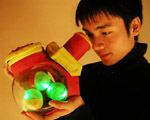
Capturing, Sharing and Reflecting Personal Histories
moo-pong--developed by researchers at Okude Lab, Keio University--is a technology that allows people to capture, share and view video images using Tangible User Interface (TUI). When a camera captures video images, they are associated with physical tokens using RFID technology. "Users can edit and browse among moving images by dropping moo-balls into the moo-scope. Mirrors in the moo-scope produce visual effects like a kaleidoscope."
The idea of connecting video/audio with physical objects is not new. For example, Durell Bishop's Marble Answering Machine represents incoming voice messages as marbles. Ullmer's mediaBlocks use small wooden blocks "for the containment, transport, and control of online media" However, moo-pong's goal is more ambitious than any classic TUI research projects: it is designed to support people to capture, share and reflect on their captured life histories.
At this year's RFID Journal Live, Paul Saffo, research director for the Institute for the Future said "You are in the early stages of helping build a real, new kind of media revolution." moo-pong can be viewed as an example for thinking about such media revolution in relation to RFID Technology. via SIGGRAPH 2005 Website. [blogged by manekineko on we-make-money-not]
Posted by jo at 08:45 AM | Comments (0)
Tactile Photography
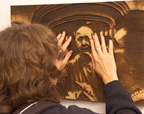
Worn by Touch
In collaboration with Mariliana Arvelo, James Patten created tactile photographic prints as part of a project about the deafblind community in Boston. The Tactile Photography pieces are produced through a CNC laser etching process that removes the top portion of the wood. The darker the image is a point, the more wood is removed by the laser. The result is a photographic relief that can be touched as well as seen.
As people touch the images, the surface of the wood continues to wear, and people's experience of the work becomes part of the work itself. No computers nor sophisticated mechanical wizzardy but that doesn´t make these works less "interactive". These images are on display until July 31, 2005 at The Gallery at the Piano Factory, Boston, MA 02118 [blogged by Regine on we-make-money-not]
Posted by jo at 08:23 AM | Comments (0)
Co-opting the Creative Revolution
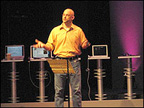
50 Years of Chaos Ahead
"Digital technology is providing people with the tools to produce and share content like never before, and it is set to throw the relationship between them and institutions into turmoil, say experts. Shirky talks of an explosion of creative collaboration "I am predicting 50 years of chaos," says leading digital thinker Clay Shirky. "Loosely organised groups will be increasingly given leverage.
"Institutions will come under increasing degrees of pressures and the more rigid they are, the more pressures they will come under. "It is going to be a mass re-adjustment," he says, addressing delegates at the TED (Technology, Entertainment and Design) conference in Oxford, UK."" Continue reading Co-opting the Creative Revolution by Jo Twist, BBC.
Posted by jo at 08:22 AM | Comments (0)
July 14, 2005
GOLDWIN

Jacket with Built-In Sound System
If you are the sort of user that doesn't like using headsets then this new jacket might be the kind of product you are looking for. Japanese company Goldwin has announced a series of products with built-in amplifier and a flat panel speaker system. The series includes different models of snowboard jackets and a backpack. Prices vary from US$300 for the backpack to US$625 for one of the jackets.
Users can connect any flash memory or hard disc based mp3 player, CD player or other sound source through a stereo jack. The sound output is through flat panel speakers which the company says provide high directivity with clear sound. The fact that the sound mixes with the background noise is an advantage according to the company, making it more "natural". The system also supports mobile phones through a built-in microphone. There is also a remote control available. The products should be in the Japanese market by end of July 2005. [via Techstyle News]
Posted by jo at 12:25 PM | Comments (0)
Resonance the Electromagnetic Bodies Project

Tesla's Innovations
Resonance the Electromagnetic Bodies Project explores the nature of invisible yet discernible material forces and the impact of these vibrating energies on our environment and the human body. Resonance is an invitation for artists to create works in response to Nikola Tesla's (1856-1943); pioneering concepts. Tesla's innovations were based on the principles of vibration and resonance in the fields of electricity and electromagnetism. Echoing Tesla's concepts the primary aim of this interdisciplinary collaboration is to consider the human body (as well as other living organisms) simultaneously as a source, a transmitter and as a point of resistance to electromagnetic waves.
Posted by jo at 11:47 AM | Comments (0)
July 13, 2005
Zapped! Workshop
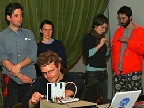
RFID Keychain Detector
Zapped! Workshop by Preemptive Media (Beatriz da Costa, Heidi Kumao, Jamie Schulte and Brooke Singer): July 15, 2005 - 6:30 - 9:00pm at Eyebeam, NYC.
You may have heard the term RFID and possibly even brought one home unknowingly. But what exactly is a Radio Frequency Identification tag? Why are Wal-Mart, the Department of Defense and the Food & Drug Administration sinking big bucks into these little chips and paving the way for mass implementation? After a brief overview of the technology and its potential impact on our lives, each participant will receive a Zapped! RFID Kit complete with a colorful workbook and materials for the hands-on portion of the workshop. Preemptive Media will guide the group through building an RFID keychain detector that plays a jingle when a reader is within range and scanning the airwaves for data. Participants can program tags that "talk back" to a RFID reader uncovered by a Zapped! keychain. Registration fee is $25 general public, $20 for Eyebeam members. Sign up here.
Posted by jo at 09:25 AM | Comments (0)
Digital Dragon Boat Race

Culturally Amplified Treasure Hunt
The Digital Dragon Boat Race (DDBR) is a competitive REAL game played on foot using wireless technology to discover 6 locations significant to the Alcan Dragon Boat Festival’s history in Chinatown and area.
The Digital Dragon Boat Race challenges teams to achieve the fastest time possible as they navigate a maze of clues leading them on a thrilling, culturally amplified, treasure hunt through Vancouver’s Chinatown and area. The Digital Dragon Boat Race is the first of its kind game experience in North America and will appeal to all levels of thrill seekers.
Posted by jo at 09:16 AM | Comments (0)
FLORA
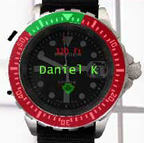
Location-Aware Watch
The FLORA (Fluorescent Light Organizing Radio Accessory), by Daniel Kantor, is a location-aware watch that helps people locate others, a mixture of a compass and the game "Hot and Cold".
When set on the Watch Mode, the FLORA displays time and date, like any other watch. To select which buddy to track, activate the Buddy Mode. The FLORA then dims the watch features and displays the name of the closest buddy to you. Once the buddy is selected, the Track Mode will change the face to red and green with green indicating the direction of the buddy being tracked. The buddy's distance will be displayed in feet. If the buddy is located in a different floor in mall a direction arrow will indicate which direction your friend is (up or down). [blogge by Regine on we-make-money-not]
Posted by jo at 08:22 AM | Comments (0)
July 12, 2005
RGB

Audience Participation in Musical Creation
RGB is an interactive musical installation for 2-9 users made by Tomas Dvorak (CZ), Alessandro Capozzo (IT) and Matous Godik (CZ). The main purpose of RGB is the idea of audience participation in the musical creation on the live performance. Communication between musicians and audience is made through specially designed flashlights. Each of them can emit 3 basic colours of the spectrum: red, green or blue. Other colours can be made by combining primary colours together.
The art content are the algorithms and schemes of the communication. Each algorithm is unique musical scheme. Every new step of the project is release of new concepts and algorithms. While first package called "Rgb 1" focused on the harmonical and tonal aspects of the musical communication, the new version "Rgb 2" focuses on more advanced sound and tembre aspects. Videos. [via]
Posted by jo at 11:05 AM | Comments (0)
48 Hour Wake
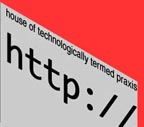
The Era of Post Autonomy
In a one off event which begins at 12 midnight Friday 22nd July and ends at Midnight Sunday 24th July, David Goldenberg and guests will take part in a continuous 48 hour wake at HTTP gallery. During this time they will stay awake while on-site inside HTTP gallery to dream, relax, take part in discussions and share ideas with a community who enter into the project.
The 48 hour wake examines how it is possible to disengage from any mindset that one inherits, along with the tradition and residues of a Euro centric art practice, before going on to develop new ways of thinking, thinking about the future of art and society, entry into the era of Post Autonomy. The event is to be web cast so that it will be seen simultaneously at a venue in Norwich gallery as part of the East Open International - along with facilities that will allow the opportunity for a wide range of persons to take part in the discussions via Voice-Over IP.
The project develops a work staged last year for the STRUKTUR show at artist: network in New York.
Address of http://
House of technologically termed praxis
Unit A2,
Arena Business Centre,
71 Ashfield Rd,
London N4 lNY
Tube Manor House
Buses: 341, 141
Train: Harringey Green lanes
Car: Free car parking facilities
Contact: Phone: 020 88022827
http://www.furtherfield.org
info[at]http.uk.net
David Goldenberg – david.postautonomy[at]hotmail.co.uk
Posted by jo at 10:47 AM | Comments (0)
Creative VR Futures

Creative Arts & Sciences in Virtual Environments
Creative VR Futures: Creative Arts & Sciences in Virtual Environments, 22-23 July 2005--A two day symposium for professional artists, designers and creative practitioners offering a range of artistic presentations, demonstrations and hands-on experience of current immersive and augmented virtual environment research. The event will take an in depth look into current artistic applications and developments of virtual/mixed reality, ranging from telepresent networking, tele-immersion and collaborative VR interaction to both painted and virtual urban landscape panoramas.
Following the symposium participants will be invited to apply for one of two artist-in-residence opportunities at The University of Salford Centre for Virtual Environments for a period of six months to develop and showcase their work.
This two day event is free. For further information and symposium booking details please contact Nathalie Edwards on 0161 295 2801 or email n.j.edwards[at]salford.ac.uk
Friday 22 July, 9.30am to 5.00pm
Centenary Building Lecture Theatre, School of Art & Design, The University of Salford, Centenary Building, Peru Street, Salford, Greater Manchester, M3 6EQ
Presentation by:
Maurice Benayoun - Interactive Media Artist, Paris
Steve Benford - Mixed Realities Lab, University of Nottingham
Monica Fleischmann - Fraunhofer/MARS, Bonn/Bremen
Horst Hoertner - Ars Electronica Futurelab
Ben Johnson - Commissioned Artist for Liverpool Biannual
David Roberts - The Centre for Virtual Environemnts, Salford
Paul Sermon - School of Arts & Design, Salford
Anthony Steed - University College London
Wolfgang Strauss - Fraunhofer/MARS, Bonn/Bremen
Saturday 23 July, 9.30am to 5.00pm
The Centre for Virtual Environments, The University of Salford, Business House, University Road, Salford, Greater Manchester, M5 4WT
Presentations and Demonstrations of:
Fraunhofer/MARS, Bonn/Bremen - Introduced by Monica Fleischmann and Wolfgang Strauss
Ars Electronica Futurelab - Introduced by Horst Hoertner
World Skin - Introduced by Maurice Benayoun
UCL EQUATOR - Introduced by Anthony Steed
The Centre for Virtual Environments - Introduced by David Roberts
Support by The Arts Council England and The University of Salford
Presented in association with Futuresonic 05 http://www.futuresonic.com
Posted by jo at 10:24 AM | Comments (0)
July 11, 2005
Touching of the Touch

Screens, Streaming, Viruses, and Performance
"The notion that is often inextricably linked to the concept of performance is one of extension: one thinks of the performing body as extended by certain technologies, and these technologies can vary widely in their nature...The body—in Stenslie’s project the body’s erogenous zones in particular—becomes extended, since the touching of one’s own suit allows for a tactile communication with another user who is wearing a similar technology. One may also conceive of the performing body as extended by a musical instrument; this is seen as a kind of transferring of the body onto the instrument, with which one communicates to the world: a voicing of one’s body; a body drawn out of itself..." From The Touching of the Touch—Performance as Itching and Scratching a Quasi-Incestuous Object by Franziska Schroeder, Extensions, Mediated Bodies: Locating Corporeality in a Pixelated World.
Also: The Intensity of Dance: Body, Movement and Sensation across the Screen by Stamatia Portanova; The Virtual Artaud: Computer Virus as Performance Art by Jason Farman; and Streaming the Performer’s Body: An Interview with Downstream by Jason Farman.
Posted by jo at 11:16 AM | Comments (0)
Transparency to Exodus:
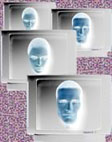
On Political Process in the Mediated Democracies
"...The most obvious contribution of the visual arts to the anticapitalist movements is the merger of community-oriented video with the distribution system offered by Internet, giving rise to innumerable non-normalized media projects that combine documentary information and expressive politics, in the lineage of Tucuman Arde. These projects carry out a specular combat with broadcast TV – that is, with the spectacle society – and in that way, they at least partially fulfill the political aspirations of the early videomakers. Another, more subtle thread is the proliferation of mail art, first through ‘zine culture and desktop publishing, then through the net, culminating in the mid-nineties in the widespread circulation of subversive texts and media pranks under multiple names like Monty Cantsin or Luther Blissett. Multiple names bring the refusal of copyright and intellectual property to the very center of ego-dominated subjectivity, in an attempt to dissolve the proprietary function of the signature which has always served as the barrier between contemplative, individualistic art and collective, interactive forms of expression. Yet another artistic contribution to the movements is performance culture, with its emphasis on the embodiment of the political, played out in its inseparability from the sexual, ritual, generational, ethnic, and psychodramatic dimensions of human experience...." From Transparency to Exodus: On Political Process in the Mediated Democracies by Brian Holmes, NOEMA.
Posted by jo at 10:08 AM | Comments (0)
Ethertouch
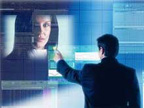
Waving Goodbye to Touch Screens
Ethertouch is working with the likes of Nokia, Bang & Olufsen and Microsoft to create applications for its touch-free technology, which can sense your finger movements in 3D. The system would replace keypads or mice with non-tactile control via motions or gestures that will enable you to simply point at a desired area of a display screen and zoom in on the relevant section.
An array of Ethertouch sensors track the position and velocity of your finger or hand as it passes through the field and convert the data into a digital signal, which is then processed. This ability to measure velocity as well as position makes the technology particularly attractive to the computer games industry, where it could enable a new level of immersion in VR gaming. The touch-free interfaces could appear on the market by the end of next year.
Other Minority Report-like interfaces: Geo-spatial gestural interface, "Data-rich" environment for scientific discovery, Raytheon's, etc. [blogged by Regine on we-make-money-not]
Posted by jo at 09:32 AM | Comments (0)
YOU-WHO

Bluetooth Enabled Social Networking Game
YOU-WHO is a social game for mobile phones that makes use of the personal area networks created by Bluetooth technology to allow players to connect, play with, and meet new people.
The game can be played in any public space where people tend to linger, such as a train station, airport, café or bar. With these varied public settings, the chances are that every time you play, it will be with a completely different person, and result in a unique game experience. Here is a PDF and a walkthrough on how YOU-WHO works. [blogged by Gerrit Visser on Smart Mobs]
Posted by jo at 09:01 AM | Comments (0)
July 09, 2005
StalkShow

Navigating the Isolation of Others
StalkShow--by Karen Lancel and Hermen Maat--deals with threat of unsafety and isolation in public spaces. The performer carries a backpack, containing a laptop with a touch screen. It is a wearable billboard, with an attached webcam that records the face of the user of the touch screen.
Passersby are invited to touch the screen and navigate through statements about insecurity and isolation. The statements were written by asylum seekers, nuns, prisoners, digipersonas and others who live an isolated life. The user can identify her/himself with one of these persons and navigate through his/her statements. The navigation is displayed by a video projection on a large screen located in the same space (train stations, museums, squares, airports, etc.) The projection shows the portrait of the person that is using the touchscreen, together with the statements superimposed over the portrait. The user "watches" through a technically created, social-psychological frame of mind which seems to have a life of its own. [blogged by Regine on we-make-money-not]
Posted by jo at 12:27 PM | Comments (0)
Report from Wired Nextfest
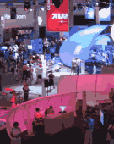
Jonah Brucker-Cohen + jonCates
Report from Wired Nextfest: Chicago, Illinois; June 25-26, 2005
In the sweltering heat of the Chicago summer, Wired Magazine's NextFest took place on Navy Pier, the city's entertainment center. Billed as "the next world's fair", the 2nd annual Next Fest (last year's event took place in San Francisco and next year's will be in New York City) was a mixture of corporate ecology culture and artistic interventions into visions of the future.
NextFest was split up into 7 categories examining projects in the future of "Exploration, Transportation, Security, Health, Entertainment, Design, and Communication." Notable projects in this year's fest included the "Entertainment" category's "Kick Ass Kung Fu", a full body Kung Fu game where participants step on a platform and fight 2D assailants. Camera tracking on movements puts players into the game screen. Other projects such as Robot Lab's "Jukebots" were repurposed car manufacturing robots that spin and scratch records on turntables.
It was nice to see a combination of hi-tech robotics next to the very "low-tech" medium of vinyl (especially since many of the kids attending the event might not even know what a "vinyl record" was. Also on the floor was "Musicbox", a souped up version of the classic music windup toy where instead of metal pins, used bright LEDs.
On the subject of kids, the Future of Exploration pavilion featured "STINKY" a submersible robot built by the Falcon robotics team at Carl Hayden High School in Arizona. Their project was featured in WIRED in an article called "La Vida Robot", as their hand-crafted robot beat MIT researchers in the "national underwater bot championship". Nearby, in the "Transportation" pavilion, was the "Moller Skycar", a flying car that looks like a 1950s red baron bomber. Videos playing beside it showed the car in action, but I have a feeling you have to be present at a test flight to really believe in it as the future of transportation.
The "Future of Health" pavilion was perhaps the most bizarre of all the collections of projects on display. Here you could see a set of real-live "cloned" cats. Also on display was Luminetx's "Veinviewer", an infrared light that when projected on the patient identifies which veins are suitable for injection or blood withdrawal. Also the "Power Assist Suit" by Japan's Kanagawa Institute of Technology is a full-body hydraulic outfit that assists senior citizens or handicapped people by calculating how much air to release to the "muscles" based on sensor input from the wearer's limbs. There was even a cyborg of Science fiction writer Phillip K. Dick that understood natural language enough for visitors to ask him questions. Unfortunately, I didn't get a chance to ask what the next Hollywood inflated-budget remake of his novels would be? Oh well, maybe next time.
Across the room from Health was the "Future of Design", which featured projects that attempted to seamlessly integrate technology into everyday experience. Sweden's Interactive Institute showed their "Energy Curtain" an augmented curtain that stores energy from the sun on flexible solar panels during the day and lights up the opposite side at night. Also integrating technology into fabric was "Urban Chameleon", a set of computationally enhanced skirts that monitored air quality, movement, and touch and displayed them on the surface of the garments. Adding interaction into the mix, the "Future of Communication" featured projects that examined how technology will (and has already) change (d) the way we connect to people over distance and within close proximity. The "Acceleglove" by students at George Washington University, is a glove that translates sign language into written characters and speech to allow for a type of "dictation tool" for the deaf. Also here was "Mobile Feelings" by artists Christa Sommerer and Laurent Mignonneau. The project consisted of two gourds that that allowed each user to share their pulse rates with each other across a minimal distance.
Finally, the "Security" pavilion focused on projects that demonstrated how "secure" we might be if we had devices that could detect unwanted visitors from miles away and conduct automated background checks on them as they approached. One of the more interesting projects was "Brain Fingerprinting", a device with electrodes that monitors brain activity and can detect when the person recognizes an image they had previously seen. Forget lie detectors, in the future nothing will be a secret.
As this year's NextFest came to a close, the question remained as to how much of this "techno fetishism" stuff will ever make it to market? When will I be able to walk into my local car dealer and take a test "fly" in the Moller Sky Car? If the future is closer than we think, this might be something that will happen in our lifetime. If not, we might find out what's "next" by dreaming it up in a bathroom stall. In any case, Wired's world fair of sorts was a good reminder that we are heading towards the future at an accelerated pace. The question that still needs addressing is: What will we do once we get there?
-- Jonah Brucker-Cohen
// jonCates
Message 2 of 2 in thread
2005-07-08 06:52:14 PM
On Jul 6, 2005, at 5:19 PM, Jonah Brucker-Cohen wrote:
>There was even a cyborg of Science fiction writer Phillip K. Dick
it isn't rilly a cyborg. it's an android (as in it dreams of electric sheep). or robot (as in it is a slave w/o the ability for autonomous behavior or creativity). or _very_ primitive replicant (as in "you see a tortoise laying on it's back...").
>that understood natural language enough for visitors to ask him questions.
"understood" is def'ly debatable. the droid {parsed|processed} natural lang well enough to generate replies. i talked to the droid after it had been rebooted but it was often _very_ oblique, abstract + inexact in it's replies to queries. i spoke w/the developers @ length + found their effort to be very sincere in their desire to both recreate a likeness of Dick + well intentioned in their densely multilayered approach to simulation + simulacra. they expressed that the droid was to be evaluated as art.
as art, the Dick droid did not reinforce a technopositivist view of inevitability of these futures but rather reinscribed the fallibility of these current + futuristic desires. the Dick droid undermined perfection, seamlessness + flawlessness not only in it's estranging replies + faltering mechanics but also in it's exposed "brain". the back of the Dick droid had a suicidally huge hole from which colorful bundles of cables + blinken lites bleed out connecting the puppet like body of the droid to it's software systems housed in boxes a few feet away. exposed in the Dick droid's skinless skull.bak were plastic cogs, servo motors, cables + blinken lites that were mainly visible thru the window from the room's exterior.
Philip K. Dick did not commit suicide. he died of a stroke in 1982:
http://en.wikipedia.org/wiki/Phillip_K_Dick#Death
but the way in which the Dick droid was left w/a skinless skull or rather a giant hole in his head keeps me thinking of self inflicted wounds such as those. i wonder about the reasoning for this detail (evaluating the droid as art or artware). functionally speaking, i assume that access to the components in the head must have been operationally crucial to the development team. sill, i can't help wondering how this hole fits in the field of resonance in relation to the Dick droid as art. did the development team hope to help ground the Dick droid in the nonhuman by exposing the materiality of the components in it's head? was this unfinished feel meant to minimize potential alienating effects of the droid? does exposing the computational clockwork electro-mechanics lessen or heighten a horror filmy zombie like identification?
representatives of Hanson Robotics, the FedEx Institute of Technology's Institute for Intelligent Systems, the Automation + Robotics Research Institute at UTA + Dick's friend Paul Williams who collaboratively [built/developed] the Phillip K. Dick robot told me that the bot + their efforts are cleared w/the Dick family. apparently Dick's daughter(s ?) had visited w/the bot in CHI IL .US before NextFest opened. when we were discussing this a person next to me commented that their conversation must have been strange + amazing. based on my experience w/the bot i wonder what if anyThin they could have discussed + sustained any sort of linear or logical path.
Hanson Robotics:
http://www.hansonrobotics.com
>Finally, the "Security" pavilion focused on projects that demonstrated how "secure" we might be
actually, the entire NextFest was extremely militarized. the military-industrial-academic-entertainment complex was well represented in celebratory + uncritical terms.
>Forget lie detectors, in the future nothing will be a secret.
on 2005.06.24 @ the Army's Full Spectrum Warrior exhibit booth, Stone, an Army representative, showed a video + distributed nfo on the Army's Future Combat Systems program. the video Stone showed (which is also available online) is set in 2014. this future war takes place in mountainous computer generated wintery landscapes (as in definitively not the desert, assuming for the moment that the war + occupation in Iraq will have been concluded before 2014). this CG'd military engagement is populated by live actors realizing networked war games as their interfaces play across the screen like the simulations of success they [imagine/fantasize].
in this future, a .US .MIL Army military-industrial-academic-entertainment dream of 2014, the Orwellian + Foucaultian [fascist/totalitarian] {surveillance|police} state apparatus will not only prevent secrets but also erase borders between nonexistent nation states allowing a decentralized nodal network of hyperlinked systems operated by young soldiers who have been pre-trained, pre-screened + pre-tested on games + systems such as Full Spectrum Warrior. currently the Army's minimum age for enlistment is 17 + the maximum age is 35. today's 6 to 26 year olds will be Full Spectrum Warriors in the Future Combat Systems' scenarios of 2014.
Army Future Combat Systems representative Stone told me that the goal of the Future War Systems is to get them (as in the enemy as in the binary opposition of us vs. them) before they even know we know about them. or perhaps he said before they even see us coming. i am paraphrasing from memory b/c i was too {taken|shaken} by the sheer honesty of Stone's comments + his seemingly solid assumption of righteousness to ask him for clarifications or to take notes while we talked. Stone was very interested in why i was so interested + began to recruit me, telling me about all of the wonderful job opportunities that exist in the Army for talented young artists like myself.
the videos Stone was showing in the Full Spectrum Warrior
http://www.fullspectrumwarrior.com
exhibition booth for the Army's Future Combat Systems are available online w/nfo about the program: http://www.army.mil/fcs/
>As this year's NextFest came to a close, the question remained as to how much of this "techno fetishism" stuff will ever make it to market?
for me the questions remain: what about the techno fetishism that are the military industrial academic entertainment art design markets? which techno fetishes are already [in/on] these markets? how do we personally develop, connect, organize + resist these + numerous other techno fetishes? to what extent are we [in/on] these markets? to what extent are we able to mobilize [in/on/against] these markets + techno fetishes?
representative Bill Walker of Northrop Grumman watched me amble around in the sprawling Northrop Grumman "booth". this booth was an open air semi-circle of model airplanes (actually autonomous Killer Bee aircraft + scale models of larger autonomous weapons, surveillance + network systems in the shape of aircraft), mockups of existing command & control war rooms + glossy promotional materials. Walker watched me snap digi picts for awhile + then said looking @ my t-hirt "SIMS?". i replied yes, it was a SIMS t-shirt, Kevin Staab to be exact + when this was met w/a cold unknowing stare i just said "old skool skateboard stuff." to which Walker replied sumThin along the lines of "i build unmanned aircraft." "ok" i thought "that is perhaps the most amazing nonsequeter of the day..."
the UAVs (Unmanned Aerial Vehicles) + UCAVs (Unmanned Combat Air Vehicles) of which we spoke are currently on the market + in the field (as in killing people today). the Northrop Grumman surveillance systems that Walker enthusiastically explained to me are on the market, in use in Iraq + (@ least tested if not currently operational) in the continental .US integrating realtime + cached cybernetic command & control systems that surveil (as in attack) subjects (as in the subjecated) thru nodal nets containing autonomous agents in the shape of tiny stealth bombers (w/the nifty name Killer Bee) as well as full sized aircraft. Walker whipped out a PDA + clicked thru hi rez imgs of "a palace in Baghdad" while explaining to me the flexibility + scaleability of the system + how intelligence like this was now available to soldiers (as in Full Spectrum Warriors) on the ground. when i saw that almost all of the video footage playing on their monitors was from the continental .US, i began to ask about their use in the States.
Walker explained to me that of course it was technically possible to fly autonomous intelligent machines in the continental .US (while my mind reeled conspiratorial hystories up + prepared to hyperthread them into the projector, played back thru a filter of my memories of Manual De Landa's War in the Age of Intelligent Machines) but that the FCC was just being cautious + slow to regulate what is permissible in the .US b/c of the implications this would have on industries such as air travel. while i was wording sum sort of question that would engage hypothetical scenarios for weaponizing unmanning aircraft on the scale of commercial airliners, Walker happily continued to relate how all of this happens everyday when pilots switch auto-pilot on @ the beginning of a flight + switch it off @ the end + how he (as a representative of Northrop Grumman) has a dream of the control tower contacting an autonomous system rather than a human pilot. Walker was quite clear that this dream is not futurist as it is exactly what is currently operational in Iraq + Afghanistan but that the FCC is currently the only barrier to making this dream a reality. when i continued to press on about if these systems were currently in use in the .US by police agencies or the .US .MIL (+ let me reiterate that much of the footage was from the .US + that Walker had gleefully told me that the people in the footage had no idea that they were being surveilled) Walker only smiled + moved on to the next ppl ambling around saying sumThin to them on the order of "you like aircraft?" i walked away allowing my signed Kevin Staab old skool pirate deck t-shirt to have the last uncomfortable [look/laugh] @ Walker + the Northrop Grumman systems.
the Cyber Warfare Integration Network, Killer Bee aircraft + the Advanced Information Architecture + ISP In The Sky from Northrop Grumman are all detailed online: http://www.northropgrumman.com
>If the future is closer than we think, this might be something that will happen in our lifetime.
again, these futures are happening + in fact (as in the case of the Northrop Grumman weapons systems) are ppl's present moments. we are in this future now but we can contend w/it if we take the time to unpack assumptions, critically question those ppl that are developing these moments + their monumental rhetorix, [decode|decompile] their systems + create our own systems, sayings + trajectories.
>If not, we might find out what's "next" by dreaming it up in a bathroom stall.
the bathroom stall doesn't seem like a great place to dream to me. maybe the bathtub if we are going to stay in the bathroom.
>In any case, Wired's world fair of sorts was a good reminder that we are heading towards the future at an accelerated pace.
this rhetorix disappears over the horizon site lines @ a Virilio like rate. Wired's NextFest did not remind me of or pull me into a vortex of accelerated futurism on the scale of a bygone world's fair era. it was instead like standing in the present moment or perhaps just slightly like the recent future of the Universe Next Door. but the futures (+ it is crucial to keep this term plural rather than singular in order to prevent ourselves from the fallacies of monolithic progress towards a single mythically inevitable technopositivist future) depicted @ Wired's NextFest were very familiar, perhaps in part b/c most have been or are [featured/marketed/technofetishized] in Wired itself + elseware.
>The question that still needs addressing is: What will we do once we get there?
the question is ware are we going? ware is these contentious futures? in the future? in the present? solid? abstract? self-justifying? lived? dead? injured? killing? on what grounds? on whose neighborhoods, streets + homes? w/or w/o justification?
++
what engines drive + power sources fuel this hypothetical time machine of NextFest or other futurist fantasies of worldly importance? how mini time machines are there? do they flower out, radiating in bifurcating branching multiverses [+/or] bubble up in quantum foamy indeterminate patterns, recursively mirrored in the net of Indra once mentioned?
++
who will we be then + there?
++
how do we anticipate, effect, shape, detourn, remix, remodel, develop, map, route, root + question these futures + our future selves?
mini Q's mini A's mini futures...
// jonCates
CHI IL .US
2005.07.08
// an illustrated (img + mpg4) + hyperlinked version of this reply exists on
// my newMedia(now&&then) blog:
http://newmedianowandthen.blogspot.com
[via Rhizome]
Posted by jo at 11:21 AM | Comments (0)
July 08, 2005
1001 nights cast
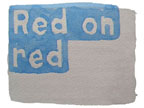
A Durational Performance
In 1001 nights cast, Barbara Campbell performs a short text-based work for 1001 consecutive nights. The performance--begun on 21 June 2005--is relayed as a live webcast to anyone, anywhere, who is logged on to http://1001.net.au at the appointed time, that is, sunset at the artist's location.
1001 nights cast is a project generated by the forces of that great compendium of Arabian tales, The 1001 Nights also known as The Arabian Nights. The project explores the theatrics of the voiced story, the need for framing devices, the strategies for survival, the allure of the Middle East and its contrasting realities. Submit a story. View the archives.
Posted by jo at 04:18 PM | Comments (0)
Becoming-Still:

Perspectives in Musical Ontology after Deleuze and Guattari
"...In a recording, even more so than in a performance, the intensities of a performance requires more deterritorializing impetus. In a performance, our expectational intensities are more and more transformed by intensities of performance simply by the musical space in which we find ourselves, insofar as there is fullness-to-explosion. In a recording, however, intensities, even expectational ones, are increasingly rooted, as we have suggested, as we come to “learn” the recording. In a performance, we are inevitably deterritorialized, at least initially, at whatever gradation our intensities of expectation at the onset. In a recording, however, we are inevitably handed a reterritorializing card. Recording is a recoding.
With a recording there is a tendency to not only recodify the music, but to recodify ourselves in the process. If we can acknowledge that each time we listen to this particular recorded performance of Varese’s “Ameriques” the music, through whatever intensities and discoveries enthusing us, is not the same, not phenomenologically-in-itself, not the sum of its sounds (in essence, potentially decoding), then the same must be true for ourselves. We bring the difference and singularity of our lives to the operating table each and every time we experience even that same (i.e., recorded) performance of “Ameriques.” This speaks of us more generally that we experience any music at every turn improvisationally. This speaks of music that it is essentially deterritorializing..." From Becoming-Still: Perspectives in Musical Ontology after Deleuze and Guattari by Michael Szekely, The Improvisor: The International Journal on Free Improvisation [via anne]
Posted by jo at 02:34 PM | Comments (0)
m.pleasure
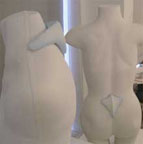
Feel the Communication
The mobile pleasure unit (m.pleasure) pushes forward the relationship we have with the mobile phone. m.pleasure works with a Bluetooth enabled phone. Attached to the most sensitive areas of our body, its intention is to translate an ethereal digital message into something physical, letting us feel the communication.
m.pleasure is also a critical approach to how we have sacrificed our personal relations for the benefit of technology: face-to-face relations are being pushed aside in favour of ever less physical communication.
As in every relationship, there will be a giver and a receiver. The Giver is totally safe, acting from their almost virtual position and sending messages to whomever they choose. The act of sending a message, however, becomes an altruist act of pleasing people.
The Receiver is placed in a completely complementary role. By connecting the m.pleasure to their body, they are rendered vulnerable and open to let technology act upon them. Receiving becomes an egotistical and carnal act of experiencing physical pleasure.
m.pleasure has been prototyped and the technology behind it already exists in the open market.
By Nagora Salaberria, at Someth;ng. [blogged by Regine on we-make-money-not]
Posted by jo at 02:12 PM | Comments (0)
Where are you?

Re-Enchanting the World
Enter the Panoscope 360° to be fully immersed in a 3D world. A 3-axis joystick will let you and your friends (up to 8) fly through the space as in dreams. The immersive display uses a PC and a hemispheric projector to project in real time a rendering of your entire horizon onto the screen.
In Where are you?--by Luc Courchesne--visitors are invited to fly, as in dreams, through a world of many dimensions, using a joystick to move in the X, Y and Z axis of a space where scale matters.
At scale 0, the world looks like a simple XYZ grid defining the experience of the navigable space. At scale +1, the world turns into an archive of pictures, sounds, texts and objects. Zooming out at scale +2, elements of this archive become particles in a "molecular" world of self-organizing clouds of lights. Zooming yet further out at scale +3 reveals a landscape of mountains and valleys.
At any moment in the Where are you? world, visitors may come upon other beings: live ones through telepresence links, pre-recorded subjects in video windows and themselves when cameras transmit their own image in this constructed world. In Where are you? the visitor controls his/her position, the path and speed of his/her journey and the scale at which he/she is prepared to "exist". Video demo. [blogged by Regine on we-make-money-not]
Posted by jo at 01:58 PM | Comments (0)
The Lake

Live Fish Performance
The Lake is a sound and animation work by Julie Freeman based on the movement of fish that are bio-acoustically tagged in a lake. The fish movements are continually monitored as it moves in the lake to compose enveloping soundscapes and transient visuals.
On the screenshot [left] of the animation, each fish is represented by a core colour and two auras all of which change colour and rate of display depending on certain behaviours. The large shapes link species together, and the debris (trails and rotation marks) show each fish's movement history over the last 5 minutes or so.
Once inside a towering structure visitors are linked live to the actual movements of the fish; melody and rhythm are coaxed out of the fish's unpredictable and unorchestrated behaviour. Suspended above people representations of the fish create an animated terrain. Changes in brightness, colour and form indicate alterations in the movement and variations in the dominance of the fish.
The Lake will be on-line with live fish data from 9 July 2005. The exhibition is open to the public Sat 9th July – Sun 2nd October 2005, at Tingrith Fishery, Bedfordshire, UK. Via organism. More "artists love fish": Fish, plant, rack, Fish-byte.net, goldfish racetrack, augmented fish reality, etc. [blogged by Regine on we-make-money-not] Read a review.
Posted by jo at 10:11 AM | Comments (0)
URBAN SCREENS 05 PROGRAM
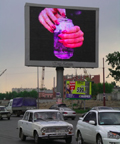
Discovering the Potential of Outdoor Screens for Urban Society
The final URBAN SCREENS 05 PROGRAM is now available.
Time: September 23-24, 2005; Location: Club 11, TPG Building, Oosterdokskade, Amsterdam; Organisation: Institute of Network Cultures, HvA/UvA, Amsterdam, Department of Art and Public Space, Gerrit Rietveld Academy, UvA, Amsterdam Urban||Research, Berlin.
URBAN SCREENS 2005 is an international conference ranging from critical theory to project experiences by researchers and practitioners in the field of Art, Architecture, Urban Studies and Digital Media. The focus is on understanding how the growing infrastructure of large digital displays influences the visual sphere of our public spaces. How can the commercial use of these screens be broadened and culturally curated to contribute to a lively urban society involving the audience interactively?
In the context of the rapidly evolving commercial information sphere of our cities, developers are bringing new digital display technology into the urban landscape like large daylight compatible LED screens or high-tech plasma screens. Meanwhile there is a growing interest in exploring their potential of a non-commercial use, asking for new strategies and cooperations in content production and management. Besides infiltrating some "artcoockies", lets look at them more in terms of open "screening platforms" and how that can have a social or cultural impact on our urban society!
Public space has always been a place for human interaction, a unique arena for exchange of rituals and communication in a constant process of renewal, challenging the development of society. Its architectural dimension, being a storytelling medium itself, has played a changing role of importance in providing a stage for this interaction. The way the space is inhabited can be read as a participatory process of its audience. The (vanishing) role as space for social and symbolic discourse has been often discussed in urban sociology. Modernization, the growing independence from place and time and the individualization seem to destroy the city rhythm and its social systems. Besides experiments with social networks and new media tools emerged. Starting with the development of virtual cities with its chat rooms and spaces for production of identity, we now face community experiments like collaborative wikis, blogs or mobile phone networks in the growing field of social computing.
Parallel to this development an "event culture" has evolved in the real urban space among the internationally competing cities, focusing on tourism and consumption. Considering the social sustainability of our cities it is necessary to look closer at the livability and openness of public spaces and start to address the urban users as citizens not as passive consumers. The experience, made in the new digital communication spheres, might serve as an inspiration for this social enhancement. Could large outdoor displays function as experimental "visualization zone" of the fusing of the virtual public spaces and our real world? Can screens function as a new mirror reflecting the public sphere?
URBAN SCREENS 05 wants to launch a discussion about how digital culture can make use of the existing and future screening infrastructure, in terms of art and social or political practices, generating a higher value for its operators and "users". We want to address the existing commercial predetermination and explore the nuance between art, interventions and entertainment to stimulate a lively culture. Other key issues are: mediated interaction, content management, participation of the local community, public private cooperation, restrictions due to technical limits, and the incorporation of the screens in the architecture of our urban landscape.
The conference aims at an interdisciplinary audience with the intention to exchange experiences and start a network to initiate future collaborations. Preparation of the event will include the launch of an online discussion on the urban screens mailinglist.
PROGRAM:
DAY 1 (23.09.05)
**************************************************************
09:30 - 10:00 Doors open
_____________________________________________________________
10:00 - 11:40 Introductory Keynote Lectures
_____________________________________________________________
Introduction by Jeroen Boomgaard and Mirjam Struppek
Moderator: Geert Lovink
Scott McQuire (Melbourne)
The Politics of Public Space in the Media City
Lev Manovich (San Diego)
Urban Media Surface: First Steps
11:40 - 11:50 10 min Break
_____________________________________________________________
11:50 - 13:00 Session 1 - Shaping the Urban Media-Scapes
_____________________________________________________________
Moderator: Bastiaan Gribling
Infoscape for the International Center of Design, St Etienne, France
Giulia Andi in collaboration (Berlin/Paris)
Integration of Screens in Architectural and Urban Design
Peter Lavery (Australia)
Intelligent Skin. Houses that Oikoborg
Vera Bühlmann in collaboration (Basel)
13:00 - 14:00 Lunch
_____________________________________________________________
14:00 - 15:30 Session 2 - Addressing the Social Value and Civic Culture
through Participation
_____________________________________________________________
Moderator: Scott McQuire
Soft Urbanism: Public Urban Media
Elizabeth Sikiaridi in collaboration (Amsterdam)
Urban Video Displays as the New Voice of Public Communications
Louis M. Brill (San Francisco)
The Shape of Content on the Urban Screen
Perry Bard (New York)
Beaming and Streaming: Developing Infrastructure for an Urban Screen
through the Creative Collaborations Project
Frank Abbott in collaboration (Nottingham)
15:30 - 16:00 Tea Break
_____________________________________________________________
16:00 - 16:30 Three Project Sketches
_____________________________________________________________
Moderator: Mirjam Struppek
'netropolis' - Information Space for Izmir Metropolitan City
Koray Tokdemir in collaboration (Ankara)
The Art of Interaction, Love Connection and Global Culture Broadcast
Valentin Tomic in collaboration (Yugoslavia)
Knowledge Spaces for Urban Screens
Studiometis (Saint Germain les Corbeil)
_____________________________________________________________
16:30 - 18:00 Session 3 - Opening the Commercial Use of Outdoor Screens
_____________________________________________________________
Moderator: Rob van Kranenburg
Art vs. Advertising - Comparative Use of Corporate Screens for Video Art
Raina Kumra (Cambridge, MA)
Commercial versus Public Service Applications
Johan Muijderman, (Eindhoven)
Social and Cultural Aspects of Outdoor Video Technology
Vladimir Krylov (Moscow)
Token Screens or Opportunity for Difference? Art Screens and the
Branding of the City
Julia Nevárez (New York)
**************************************************************
DAY 2 (24.09.05)
**************************************************************
10:00 - 10:30 Doors open
_____________________________________________________________
10:30 - 11:50 Session 4 - Future Technology of Outdoor Screens
_____________________________________________________________
Moderator: Geert Lovink
Media-Facades: Use, Mutation and Technologies
Jürgen Meier (Leipzig)
Future Urban Screens - New Concepts for Urban Screens
Florian Resatsch in collaboration (Berlin)
Cityspeak : From Private Expression to Public Performance
Jason Lewis (Montreal)
11:50 - 12:00 10 min Break
_____________________________________________________________
12:00 - 13:45 Artists Presentations
_____________________________________________________________
Moderator: Jeroen Boomgaard
Architectural Media Space
Linda Wallace (Amsterdam)
(Tele)interventions in Cybrid Public Spaces
Giselle Beiguelman (Sao Paulo)
Stalk Show
Karen Lancel (Amsterdam)
Etre = Réseau: From scenography to planetary network
Franck Ancel (Paris)
Energie_Passagen [Energy_Passages] - Reading and (De)Scribing the City
Wolfgang Strauss in collaboration (Germany)
13:45 - 14:30 Lunch
_____________________________________________________________
14:30 - 16:15 Session 5 - Experiences with New Content Creation and
Curation
_____________________________________________________________
Moderator: Bill Morris
Curating the Zuidas Urban Screen
Jan Schuijren (Amsterdam)
Audiences on the Move - The Bigger Picture
Kate Taylor (Manchester)
Video as Urban Condition
Anthony Auerbach (London)
Outvideo - International Videoart Festival in Public Spaces
Arseny Sergeev, a.o. (Ekaterinburg)
Near Documentary - the Public Screens of the Schaulager
Sabine Gebhardt Fink (Zurich)
16:15 - 17:00 Final Keynote Speech
_____________________________________________________________
Two Years Public Space Broadcasting in the United Kingdom
Mike Gibbons (London)
**************************************************************
For more information on the sessions, lectures and speakers see the Urban
Screens website:
Contact: Mirjam Struppek
urbanscreens[at] networkcultures.org
Institute of Network Cultures
Urban||Research
Posted by jo at 08:06 AM | Comments (0)
July 07, 2005
Sleeping Dogs Lie - Part 2 - untitled

Navigable Cinema
Sleep and Insomnia. Alcohol. Drugs. Crime. Love making. Rock 'n' Roll. Memories. Distances seem to change. In the night, one's thoughts go from city to city, from one place to another, dreaming of another life in each other's place.
e-Xplo will create and present four performances of Sleeping Dogs Lie, a specially commissioned audio coach tour of nocturnal NewcastleGateshead in a coach equipped with an audio system and GPS receiver. The performance combines pre-recorded and live electro-acoustic sound, transforming the ordinary coach into a navigable cinema.
We cannot escape the politics of the sites we choose, and even in mapping a tour, even in struggling for the visual element, we cannot avoid the specifics of the place entirely. Having said that, how may our concerns be heightened by the visual, historical, architectural, acoustic and political circumstances of Newcastle? The night challenges us to enter a process of constructing and reconstructing topographical views on the subject.
e-Xplo develops maps, routes, sound and film materials as reflections of a multifaceted investigation into location, context, social identity, landscape, and the public space of information.
Each work proposes distinct but related topics, thus focusing on specific issues for concrete places while searching for broader insights.
e-Xplo is the framework for the collaboration between Erin McGonigle, Heimo Lattner, and Rene Gabri. Since 2001 they have organized bus tours in Budapest, Massachussetts, Berlin, London, Eindhoven/Rotterdam, Turin, and New York. [via net art review]
Posted by jo at 10:43 AM | Comments (0)
God's Little Toys
Confessions of a Cut & Paste Artist
"Our culture no longer bothers to use words like appropriation or borrowing to describe those very activities. Today's audience isn't listening at all - it's participating. Indeed, audience is as antique a term as record, the one archaically passive, the other archaically physical. The record, not the remix, is the anomaly today. The remix is the very nature of the digital.
Today, an endless, recombinant, and fundamentally social process generates countless hours of creative product (another antique term?). To say that this poses a threat to the record industry is simply comic. The record industry, though it may not know it yet, has gone the way of the record. Instead, the recombinant (the bootleg, the remix, the mash-up) has become the characteristic pivot at the turn of our two centuries.
We live at a peculiar juncture, one in which the record (an object) and the recombinant (a process) still, however briefly, coexist. But there seems little doubt as to the direction things are going. The recombinant is manifest in forms as diverse as Alan Moore's graphic novel The League of Extraordinary Gentlemen, machinima generated with game engines (Quake, Doom, Halo), the whole metastasized library of Dean Scream remixes, genre-warping fan fiction from the universes of Star Trek or Buffy or (more satisfying by far) both at once, the JarJar-less Phantom Edit (sound of an audience voting with its fingers), brand-hybrid athletic shoes, gleefully transgressive logo jumping, and products like Kubrick figures, those Japanese collectibles that slyly masquerade as soulless corporate units yet are rescued from anonymity by the application of a thoughtfully aggressive "custom" paint job." From God's Little Toys: Confessions of a Cut & Paste Artist by William Gibson, Wired.com
Posted by jo at 09:32 AM | Comments (0)
Art and Computer Programming

Process or Product?
"Art and hand-waving are two things that a lot of people consider to go very well together. Art and computer programming, less so. Donald Knuth put them together when he named his wonderful multivolume set on algorithms The Art of Computer Programming, but Knuth chose a craft-oriented definition of art (PDF) in order to do so. Is Programming Art?
What the heck is art anyway, at least as most people understand it? What do people mean when they say "art"? A straw poll showed a fair degree of consensus--art is craft plus a special degree of inspiration. This pretty much explains immediately why only art students and art critics at a certain sort of paper favor conceptual art. Conceptual art, of course, often lacks a craft component as people usually understand the term." Continue reading Art and Computer Programming by John Littler, ONLamp.com.
Posted by jo at 09:07 AM | Comments (1)
July on empyre
Join the Discussion
Helen Thorington and Michelle Riel are guests on the empyre list for July 2005. The following are their first two posts on the subject of networked performance. You are invited to join the discussion: to subscribe and contribute, go here.
1. Greetings empyre:
First of all thank you for inviting us to be guests at empyre this month. Jim, especial thanks to you for encouraging our participation.
We are proposing a return to the subject of networked performance, which this list dealt with in September 2003, and a second look, this time from the perspective of recent new and transitional work.
On July 14, 2004, we (Jo-Anne Green of turbulence.org, Michelle and Helen) launched the networked_performance blog to explore the shifting paradigms in performative cultural practice. Our goal was to take the pulse of current network-enabled performance practice, to obtain a wide range of perspectives on current issues and interests—which we felt were under-examined—and uncover common threads that might help shape a symposium in 2006.
We didn’t expect what we found.
With more than 1,000 entries in its first year, the networked_performance blog reveals an explosion of creative experimental pursuits, as artists investigate the possibilities opened by the migration of computing out of the desktop PC and into the physical world, and by the continuing advances in internet technologies, wireless telecommunications, sensor technologies and Geographic Information Systems (GIS).
The ephemeral conceptual art practices that came into existence during the 50s and 60s – with Happenings, Fluxus, the Situationists – and that re-emerged as participatory works on the Internet in the early ‘90s, are now, with mobile networking technologies, networked sensors and embedded computing, proliferating as new ways of working and experiencing.
The interest in these emergent practices is keen, as the 150,000 visitors to the blog attest.
For the purpose of this presentation to the empyre list, we’ve defined networked performance as any live event that is network enabled. There is nothing clear-cut about what we are presenting – it’s exploratory and necessarily messy. But we see a great advantage in beginning to look at this outburst of new work – in chronicling it, understanding its commonalities and beginning to think about how it impacts our notions of performance.
We would therefore like to start by setting out four broad categories under which this new work falls, suggesting works within each that are particularly meaningful to us, namely works that occupy liminal spaces – the in-between – and are transformative and generative. We would like to invite the originating artists to describe their work, and then proceed by posing questions for the empyre list, such as: “How do we understand performance in relation to these new activities that are between the existing and the developing, and what can we learn from stretching our understanding of performance in light of these perspectives?”
2. Surveying the blog we identify four areas of networked performance practice which current work explores in various combinations. We have categorized these as (1) telematic events, (2) locative media, (3) wearables, and (4) active objects and responsive environments.
Telematics connect people to people or people to objects through a network, such as telerobotics or haptics; locative media provide location aware engagement; smart environments enable architecture and objects to respond to environmental changes of state generated by occupants/inhabitants; and wearables extend the body's senses through technological prosthesis.
We see lots of overlap and combinations in the works we survey, so these are not to be considered rigid categories but an effort at broad representation. We’re keenly interested in the commonalties across emergent art/technology practice with attention to artist/audience/object/environment, performativity and the open work.
1. TELEMATIC EVENTS
To date this has been the most prolific, comprehensible/understandable area of practice, encompassing the exploration of networked performance by the traditional performing arts where new technologies are integrated into existing forms (dance, music, theater). Examples of this would include the musical performance. InteraXis with Jesse Gilbert, Mark Trayle and Wadada Leo Smith and dance performances such as those created by AdaPT, an interdisciplinary association of artists, technologists and scholars.
http://www.turbulence.org/Works/interaxis
http://www.dvpg.net/adapt.html
Others move us onto new terrain. Jeff Mann and Michelle Teran, for instance, create performance events that explore new ways for computers to support social experiences in the physical environment. Their objective is not performance for an audience but creating a shared experience in which everyday social spaces become “electronically activated play environments, capable of transmitting the physical presence and social gestures that comprise…human interaction” across time and distance. No longer dependent on the work-based screen and keyboard, in these environments ordinary goods and wares – furniture, cutlery etc. – “come to life as both kinetic art and telecommunications interfaces”.
http://www.lftk.org/tiki/tiki-index.php
http://www.lftk.org/tiki/tiki-index.php?page=Telepresence+Picnic
http://www.interaccess.org/telekinetics/template.php?show=intro
2. LOCATIVE MEDIA
Locative media practice has exploded since the public availability of GPS and its consequent inexpensive and ubiquitous availability in mobile electronic devices. Some of this practice makes urban areas into game boards and city infrastructures into play spaces. Blast Theory, a London-based group, is renowned internationally for their contribution to this genre with works that make a public space ‘playable’ by participants in the street and online.
http://www.turbulence.org/blog/archives/000221.html
http://www.turbulence.org/blog/archives/000033.html
Others create “geo-annotation projects.” This involves assigning geo-spatial coordinates to media content so that it can be accessed at a specific geographical location with an enabled device. While the “true” location of the content is a database, by making it possible to access that content from a particular location, its place (so to speak) migrates into the physical environment, making urban streets and the landscape “programmable.” Urban Tapestries and the Aware Platform are examples of this. Both are location-based wireless platforms that allow users to access, author and share location-specific content (text, audio, pictures, and/or movies) – But there are many more: Yellow Arrow, Grafedia, MapHub, and, as Anne Galloway says, “ and oh, about a million others now.”
http://www.turbulence.org/blog/archives/000151.html
http://www.turbulence.org/blog/archives/000555.html
There are also projects specifically designed to enable communication and shape transient networked communities. Yuri Gitman’s Magicbike turns common bicycles into WiFi hotspots that broadcast free WiFi connectivity to their proximity. And Jonah Brucker-Cohen and Katherine Moriwaki’s UMBRELLA.net develops ad-hoc networks based around the haphazard and unpredictable patterns of weather and crowd formation. The system consists of a set of umbrellas as nodes that can spontaneously form a network when unfurled.
http://www.turbulence.org/blog/archives/000114.html
http://www.turbulence.org/blog/archives/000051.html
3. WEARABLES
Wearable computing enlarges the use of computers to include wearing them on ones body—much as eyeglasses or clothing are worn—and facilitates interaction with the user, and between users, based on specific situations. Fionnuala Conway and Katherine Moriwaki’s Urban Chameleon, for instance, is comprised of three skirts: 1) “Touch” changes visual properties upon contact; 2) “Speak” reacts to urban noise; and 3) “Breathe” visualizes pollution and urban exhaust as it travels through the garment.
http://www.turbulence.org/blog/archives/000146.html
Tina Gonsalves’ Medulla Intimata is responsive video jewelry. The overall function of the piece and its video content is to reflect the full character and content of the wearer’s emotions and thus present a fuller living portrait: the wearer as he/she is in unmediated interaction and the wearer as he /she feels at that moment.
http://www.turbulence.org/blog/archives/000137.html
4. ACTIVE OBJECTS AND RESPONSIVE ENVIRONMENTS
Increasingly, through ubiquitous/pervasive/ambient computing paradigms and wireless sensing, artifacts, objects and physical space itself are being charged with properties traditionally associated with living bodies.
In their recent Benches and Bins, Greyworld creates furniture that is able to roam freely through the new public square in Cambridge, England and respond to its surroundings and ambient movement.
http://www.turbulence.org/blog/archives/000335.html
http://www.junction.co.uk/HTMLTemplates/our_work/news/digital/Bins___Benches_to_be_Unleashed.htm
http://www.greyworld.org/contact/index.html
While Chris Salter, in the environment-inhabitant interaction Suspension / Threshold, focuses on the theme of thresholds or bardo (in between) states, and creates a body responsive environment where the aggregate breathing patterns of the collective audience/participants lighten an otherwise dark environment.
http://www.turbulence.org/blog/archives/000053.html
Much of this work is conceived to provoke interaction between people, and between people and their spaces. More than not it encourages people to be performers within the work and thus to enable or realize the work. This calls into question the accepted nature of performance and introduces a shifting relationship between the artist, artwork and audience.
We locate this practice within an historical continuum (Kaprow’s “Happenings,” Galloway’s “Electronic Café,” “Experimental Art and Technology (EAT),” the Situationists, Fluxus, etc.) and suggest that this trajectory is redefining the performative as a socially networked, collaborative model for artistic and cultural practice.
The overarching question, then. is:
“How do we understand performance in relation to these new activities that are between the existing and the developing, and what can we learn by stretching our understanding of performance in light of these perspectives”?
Other questions we are interested in include:
1. How is performance changing in response to networked computing technologies (mobile, satellite/GPS, internet)?
2. What is the relationship of 'real-time' computing to liveness and performativity?
3. What is the relationship of agency and authorship to performativity? Is performativity synonymous with being an actor, agent, or author? Is “performer” another label for the user/viewer/visitor/ of an interactive work?
4. As the use of the network becomes more social, adopting the peer-to-peer model, what does this imply for performance and net.art as performative?
5. How are network processes (algorithmic, procedural rule-based systems, generative) influencing or being investigated by performance?
6. How are networked concepts as modes of communication (granularity, open source, emergent behavior, affordance, latency, ubiquitous computing) impacting performance?
-- Helen and Michelle
Posted by jo at 07:40 AM | Comments (50)
July 06, 2005
PlaceSite:
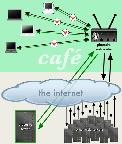
Breaking the social barrier between Wi-Fi and cafe society?
Occasional smartmoblogger and flashmob namer Sean Savage has unveiled his project, an attempt to break the barriers between Wi-Fiers and more convivial cafe society. Wired News covers the story:
"Sean Savage wants to hook you up by tearing you away from the internet.
The one-time promoter of flash mobs is once again waging battle against digital alienation with a new tool aimed at getting Wi-Fi cafe "zombies" to look up and smell the coffee. The problem: Computers are fabulous at connecting people over a long distance, but they can become a wall between people who are sitting right next to each other.
At the O'Reilly Where 2.0 conference in San Francisco last week, Savage announced his latest project, PlaceSite, which combines online social networking with real-life networking in Wi-Fi cafes by providing computer users with a website unique to a particular Wi-Fi cafe.
"We thought about what if you could use technology to reduce the zombie effect or to promote (people) to be more conscious and less alienated from their neighbors," Savage said." [blogged by Howard on Smart Mobs]
Posted by jo at 12:50 PM | Comments (0)
Façade + Auto Mata
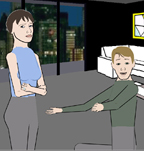
Finally, the Curtain Opens on Façade
This long-awaited one-act interactive drama, featuring a 3D environment and voice-acted, AI-driven characters, Façade has been a testbed for research in and development of new discourse-based NLP techniques, a new drama management framework, and new ways of allowing behavior hierarchies to interact. It has been the source of more than a dozen academic publications co-authored by Michael and Andrew, as well as Michael’s Carnegie Mellon University Ph.D. dissertation. A pre-release version of Façade was a finalist in the 2004 Independent Games Festival. Façade is also delightfully entertaining and abundant in its dramatic and artistic merits. It offers a fairly short dramatic experience that is intensive and compelling, and unlike anything else I have seen in video games or other interactive systems.
The New York Times called Façade “the future of video games” and one person who has devoted his life to interactive storytelling, Chris Crawford, said the system was “the best actual working interactive storyworld yet created.” You can read the official press release on Façade, read on for more about the release, or skip directly to the download page on InteractiveStory.net.
From there, you can download the 800MB program via BitTorrent; Andrew and Michael also provide the program on two CDs which are sold at cost, for $14 plus shipping.
Since the program is provided for free and and the CDs set is sold at cost, and because you like schwag, you may also be interested in supporting the creators of this system by purchasing some of the Façade merchandise that is available. The items for sale include the “hint book” Behind the Façade, which Andrew and Michael will email for a donation of only $5; there are also T-shirts, a hat, and other items.
Although we love for you to post comments here, and hope that you will, there will also be a bulletin board set up on InteractiveStory.net for detailed discussions of matters related to Facade. I can’t wait to hear what others think of this piece. Michael and Andrew tell me that they are also eagerly looking forward to people’s feedback about, comments on, and criticism of the first fully-realized prototype interactive drama, Façade. [blogged by Nick on Grand Text Auto]
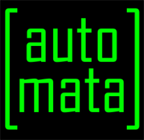
Auto Mata: A New Label for Computer Lit, Art, and Games
Auto Mata, an independent label for extraordinary e-lit, digital art, and computer games, has just been launched by the six “drivers” of the blog Grand Text Auto: Mary Flanagan, Michael Mateas, Nick Montfort, Scott Rettberg, Andrew Stern, and Noah Wardrip-Fruin.
Façade, the long-awaited one-act interactive drama by Michael Mateas and Andrew Stern, is the first Auto Mata release. The interactive fiction Book and Volume is in the works now and will be coming from Auto Mata soon. [via elo blog]
Posted by jo at 12:22 PM | Comments (0)
Ambient Intelligence:

Changing Forms of Human-Computer Interaction and their Social Implications
"Abstract: Ambient intelligence appears poised to cause remarkable changes in the way people live. With digital information, the ease of interaction between humans and computers can be greatly increased by broadening the interface media available and allowing for mobile and portable communication free of inhibiting wires and stationary units. Additionally, some forms of ambient intelligence allow computers to adapt to their user's preferences. The result of ambient intelligence is ultimately a more empowered computer with the benefits of added convenience, time and cost savings, and possibilities for increased safety, security, and entertainment. This technology has the potential to significantly impact business and government processes, as well as private life. The paper describes developments to date in ambient intelligence and its closely related counterpart, ubiquitous computing and communication. It discusses the driving forces behind this digital information technology, describes the equipment and devices involved, the obstacles to implementing ambient intelligence on a large scale in real-world scenarios, and considers the future outlook. The authors believe that the introduction of this digital information technology will have wide-ranging implications, which will for the most part be beneficial and valuable." From Ambient Intelligence: Changing Forms of Human-Computer Interaction and their Social Implications by Mahesh S. Raisinghani, Ally Benoit, Jianchun Ding, Maria Gomez, Kanak Gupta, Victor Gusila, Daniel Power and Oliver Schmedding; Journal of Digital Information, Volume 5 Issue 4
Posted by jo at 12:03 PM | Comments (0)
VJTheory book
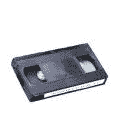
Call for Participation
VJ Theory: Philosophy and Cultural Theory of Vjing and Realtime Interaction: Keywords; narrative, philosophy, psychoanalysis, cultural theory, ephemeral, performance, technology, aesthetics, politics, ethics, realtime processing, collaboration, integrating media.
During AVIT UK 05 there was a fantastic level of debate based on both the theory and practice of VJing and realtime interactive installations and the questions those practices rise. Paul and Lara have been organizing Narrative Lab, a program of lectures, screenings, performances and projects as a major strand of AVITUK since 2003. The group has been seeking to encourage debate, spark new work arising from theory and facilitate collaboration examining the territories of narrative. Over the last two years the narrative Lab has hosted lectures on hypertextuality, meta narratives, psychogeography, screen aesthetics, structuralism, process methodologies and various production techniques.
These theoretical debates have now expanded across many of the other sessions. What became apparent was the lack of written texts which attempt to deal with these questions which involves everybody's practice. With this in mind we propose to gather a collection of articles and essays which begins to deal with these new media debates.
We see this volume as paralleling the early anthologies of film criticism, such as 'Movies and Methods' by Bill Nichols, containing a broad range of analytical perspectives relating to the new medium.
This is an invitation to submit a short synopsis, propose an article or ideas to be published as a book.
Please send it to the following e-mail address:
vjtheory[at]yahoo.co.uk
Here are some suggested areas, please feel free to suggest your own:
1- Narrative and hyper narrative
+ The cultural position of narrative
+ Meaning in narrative
+ Narrative Structures
+ New narrative
+ Cognitive process and discourseNarrative Practice
2- Ethics
+ Copyright and "copyleft" (the creative commons open source software and gnu licensing)
+ Cross cultural appropriation of imagery themes and content (sources for video and other visual assets and it's relation to the social)
+ Commercial sponsorship and market flooding
3- Real time processing and the problem of the "now"
+ Problem of the 'real' and the problem of the "now"
+ Internet realtime data
4- Collaboration and rhizomic relations
+ Vj <> Dj/ Network collaborations
5- Philosophical and cultural perspectives including
+ Phenomenology
+ Language and the body
+ Schizoanalysis
+ Semiology
+ Feminist analysis
+ Deleuzian movementImage Habermas and the relationships with cinema and theatre
6- Interaction
+ Public/ work interaction (how much should the interaction be apparent to the user of an installation for example)
+ Vj <> interaction
7- Software
+ Open source and proprietary software
+ Latest software developments and software in development
+ Software and ideas led production of work
8- Aesthetics
+ Moving wallpaper
+ The problem of the formal time/movement image
+ Control and the dispersal of control
+ Crafting the image and its relations
+ Abstract animation (e.g. Oscar Fischinger, Len Lye) and it's relation to reactive 3D modeling.
Posted by jo at 11:53 AM | Comments (0)
Towards Professional Participatory Storytelling:

Mapping the Potential
"Abstract: The impact of the Internet on the professional identity of media professionals whose work is defined by creative storytelling — whether in advertising, journalism, public relations or related fields — is the theme of this presentation. The central question raised is to what extent storytelling can be content- or connectivity-based, and what level of participation is included in the narrative experience. This presentation features examples and analyses of contemporary media work between content versus connectivity, and between moderated versus unmoderated participatory communication." From Towards Professional Participatory Storytelling: Mapping the Potential [PDF] by Mark Deuze, Indiana University. Presented at: MiT4: The Work of Stories; May 6-8, 2005; MIT, Cambridge, MA. [via HypergeneMediaBlog]
Excellent excerpts:
"It could be argued that media users never existed as audiences — people were framed that way for a brief moment in time one may call the 20th century. However, almost all of the professional and scholarly literature on journalism and advertising in the United States and The Netherlands consolidated and reified the notion that the stories these media professionals were expected to tell served to inform, persuade, entertain and enlighten an otherwise more or less anonymous 'mass' audience. To some extent this accounts for the top-down, (informally) hierarchical, routinized and bureaucratized organization of news companies and advertising agencies — a physical and social organization that by its sheer culture of doing things seems to exclude multiple-way communication or any kind of meaningful dialogue between media users and producers.
"In other words: in a contemporary ecology where American and Dutch people of every ilk seem to be immersing themselves almost constantly in media, the people still earning the bulk of their salaries producing media content do not or even cannot see them as their peers."
"Audiences, clients, sources and publics are the Other, kept at bay by structural couplings — as professed in mantras like 'serving the public' or 'creating added value for the customer' — but cannot be considered to have any direct role in the everyday praxis of media work. Surveys among journalists in The Netherlands and the United States for example show how they appreciate and value feedback from members of the audience, but that these reporters and editors at the same time would not change their ways of doing things on the basis of critical feedback received from the public.
"The literature on journalism and advertising suggests that ultimately media workers primarily seek recognition and acclaim only from their colleagues and not necessarily from citizens or consumers."
"A continuation of existing models of professional identity is meaningless unless it coincides with a radical reworking of the basic premises underlying our concept of professional identity in the media industry. I would like to argue that a future professional identity of media work could only be maintained if it includes a participatory culture as for example indicated by a notion of storytelling as a collaborative experience embedded in is mode of operation. In other words: Advertisers and journalists should be trained to think about the stories they tell as co-created with people who they used to name (and thus effectively excluded as) audiences, users, consumers or citizens, but who are now Rosen's aforementioned 'egocasters,' living in a thoroughly individualized culture dominated by personal technologies (like the cell phone, the laptop computer, the digital video recorder and the ubiquitous remote control), annotating and assembling their own, highly customized reality through the media."
Other interesting research presented at MiT4:
• Digital Stories of Community: Mobilization, Coherence and Continuity (PDF, 181kb)
• How Story Can Tell Games: Narrative and Micronarrative as Components of Game Experience (PDF, 188kb)
• Locating Story: Collaborative Community-based Located Media Production (PDF, 936kb)
• Narrative and Mobile Media (PDF, 386kb)
• The Seductive Storyteller: Authorial Decentralization and the Questionable Invitation to Play within Contemporary Narratives (PDF, 201kb)
• American Media Trinity: The Truth, the News, and the Presumptive Narrative (PDF, 145kb)
• Narrative Knowledge: Knowing through Storytelling (PDF, 192kb)
• The Narrative Imagination Across Media: Dreaming and Neil Gaiman's Sandman (PDF, 96kb)
• Complete list of abstracts and papers presented
• Streaming audio and video from various panels
Posted by jo at 08:40 AM | Comments (0)
July 05, 2005
Tactical Media Cookbook

CALL FOR SUBMISSIONS
Tactical Media Cookbook is a web project organized by Finishing School that will share data related to the practice of tactical media. TMC will present various working theories that are associated with the practice of tactical media, supply concise project recipes from various tactical media practitioners, and present a directory of tactical media practitioners.
Finishing School will be exhibiting TMC in “Urban Networks”, an exhibit organized by curator Susan Joyce for Art Interactive in Cambridge, Massachusetts, USA in June 2006. The project will also be available permanently at tacticalmediacookbook.net.
Posted by jo at 10:07 AM | Comments (0)
a_mirror

Continuous Portraiture
a_mirror--by Limiteazero--is an installation comprised of a glass mirror, which reflects both in a physical and virtual way. It explores the present at different reading levels, including a continuous flow from present to past. Standing in front of the mirror, an image gets physically reflected in it; then a graphically modified image softly appears as a second level of reality, a sort of interpretation of the real image. The piece is wirelessly connected to the internet: lightly touching the small metal disc in the center of the mirror, the current image on the screen is grabbed and uploaded on a specific url on the internet.
Posted by jo at 09:59 AM | Comments (0)
Targeting the 'Art' Around Every Corner
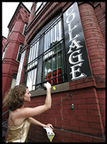
Yellow Arrow Stickers Make a Personal Point About a Public Space
"...Launched last summer by Counts Media, a New York-based arts and gaming company, the Yellow Arrow Project is a kind of geographical blogging. Adherents have been placing the palm-size stickers -- each with a unique code -- on street signs, city monuments, store windows, abandoned buildings -- anywhere, really, that observers encounter what they deem to be "art." Then, using a cell phone, they send a brief text message -- which could be an interesting historical fact, a restaurant review or just some goofy poetry -- to Yellow Arrow. People who come across an arrow can call the Yellow Arrow phone number, punch in the sticker's code and receive that message." Continue reading Targeting the 'Art' Around Every Corner by Tommy Nguyen, Washington Post, Saturday, July 2, 2005; Page C01. [via smartmobs]
Posted by jo at 07:52 AM | Comments (0)
APCompass
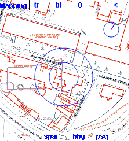
Pioneering and Exploration
APCompass, by David Wiltshire, is the prototype application of the gpsMiddleware platform. It uses GPS technologies integrated with a community maintained database to allow people to explore their local wireless networks. There is an emphasis on pioneering and exploration as users seek out new nodes to extend the database. The project considers issues of privacy, by ensuring every action performed by the user is broadcasted to a central server for anyone to see. Drawing on David Brin's idea of a ‘Transparent Society' APCompass encourages collaboration and accountability as users appreciate the fact that their actions are being constantly monitored.
gpsMiddleware is a custom built C++ application developed explicitly for providing a link between a palmtop computer and a global positioning system. The underlying software is available for download and adaptation for members of the community, so that it can be used as a basis for developing a range of creative applications. [via we-make-money-not]
Posted by jo at 07:49 AM | Comments (0)
Urban/Social Tapestries
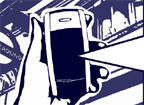
Final Reports
Proboscis has recently released the final reports on the Urban Tapestries project. You can order them here. ]The reports are free for private use by individuals, academics and non-profit organisations in the arts and civil society sectors.]
Urban Tapestries: Public Authoring, Place and Mobility A Proboscis White Paper by Giles Lane & Sarah Thelwall: This white paper presents our vision for public authoring and our conclusions on its relationships to place and mobility. We argue for design solutions to focus on actual people in real world contexts and situations, offer insights from the public trials of our prototypes and set out Proboscis’ own future vision and research agenda. Finally we recommend a series of policy proposals for realising a public knowledge commons, structured around place.
Urban Tapestries: Project Report
A Proboscis Report by Giles Lane & Sarah Thelwall
This report gives a chronological account of the development of the project and provides detail of and context for the key issues that arose over its two year span. In describing the activities and outcomes of the project it also connects the completion of Urban Tapestries to the research brief for Social Tapestries, a follow on research programme. A summary of the outputs, press coverage, some statistics and project credits are listed at the end of the report.
Urban Tapestries: Observations and Analysis
A Proboscis Report by Giles Lane, Alice Angus, Victoria Peckett & Nick West
This document presents the observations and qualitative evaluation of participant activity and feedback from the bodystorming experiences, the public trial of December 2003 and the field trial of June/July 2004.
Complimentary copies are available for affiliates, project funders and partners. Commercial organisations, government departments and government agencies are requested to purchase reports – bound copies will be posted to the billing address.
Posted by jo at 07:32 AM | Comments (0)
July 04, 2005
Kick Ass Kung-Fu
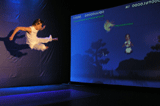
An Embodied Gaming Experience
Kick Ass Kung-Fu is an immersive game installation that transforms computer gaming into a visual, physical performance like dance or sports. You can fight and defy gravity like kung-fu movie actors - only there's no wires or post-production needed, thanks to the real-time embodied interaction and virtual set technology.
The game takes place on a 5 meter cushioned playfield suitable for martial arts and acrobatics training. Using custom computer vision technology, you are taken inside an artificial reality where the normal laws of physics no longer apply. Your movements are exaggerated so that you can easily dodge your opponent's bullets by jumping five meters in the air and landing behind his back. Using the dual projected screens, one at each end of the playfield, you can also continue by counter-attacking your stupefied enemy from the behind. [via pasta and vinegar]
Posted by jo at 12:23 PM | Comments (0)
receiver #13
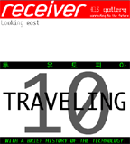
Looking East
Receiver #13: Looking East is out: East Asia is the most "unwired" region in the world. Half of all SMS transferred are sent by Chinese users, Japan has the most advanced mobile internet services, and Seoul is the most intensely digitally mediated urban space you can find. This receiver issue approaches digital mobilization the East Asian way.
Daisuke Okabe and Mizuko Ito: Personal, portable, pedestrian images; Anthony Townsend: Seoul searching – cybernomads and the ubiquitous city
Weigui Fang: China's culture of the thumb
Atau Tanaka: Malleable contents and future musical forms
Shin Dong Kim: Mobile media mobilize generations
Kenji Kohiyama: Mobile communication and place
Yat Siu: Eight visions from mobile Asia
Seiko Mikami: The perception and interfaces continuum
Posted by jo at 11:23 AM | Comments (0)
The R.g.b-project
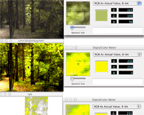
Color Walk-Through
The R.g.b-project--by Jacky Sawatzky--is an experiential project, which invites participants to interact with the city through the concepts of the RGB-color space, a color space commonly used by digital technology. Participants are asked to go on a color-walk through the city, using a video camera to document one of the three colors, Red, Green or Blue. Consequently, the created clip is inputted into a computer program the artist wrote. This computer-program acts, as a surveillance machine through only highlighting what the program 'thinks' is red, green or blue. If the program can't find the specified color, the sound of the clip is heard. Read Jacky's thesis [PDF]
Participants comment on the project as an experience that heightened ones awareness of digital technologies interpretation of color. The results of the project show that this interpretation can be dubious at times. Crucial is the difference in method each participant used while creating the clips. Some had a documentary style approach. Others perceived the instructions as a framework for a performance and some created a conceptual dialogue with the parameters of the computer program. For more information download the thesis on the project page.
Posted by jo at 07:44 AM | Comments (0)
UpStage
![]()
Next Walk-Through Session: July 6
Yes folks, it's that time of the month again: the next UpStage Walk-Through will be held on Wednesday 6 July at the following times: California: 1am; Ontario: 4am; New York: 5am; UK: 9am; Western Europe; Finland: 11am; Sydney: 6pm; NZ: 8pm. Check http://www.worldtimeserver.com for your local time. To participate, please email helen[at]upstage.org.nz for a username to log in.
NOTE: If you have previously attended a walk-through using one of the guest log-ins, you still need to email me for a new log-in before turning up as we reissue the guest log-ins, so you could end up trying to log in with the same one as someone else. Log in at http://upstage.org.nz:8081/; you will arrive in the workshop. At the right is a link to the Introduction stage, and this
is where we'll meet for the walk-through. If you want to join us as an audience member, come directly to: http://upstage.org.nz:8081/stages/presentation.
Posted by jo at 07:34 AM | Comments (0)
Music Insects

Tool for Visual Music Performance
Music Insects by Toshio Iwai (1992). Permanent collection at the Exploratorium, San Francisco, U.S.A. These "music insects" "react" to color dots on the screen. When they pass over the dots, they trigger musical scales, sounds, and different light patterns. The user selects colors from a palette with a track ball, and paints in their path, and the insects perform the colors when they pass over them. The insects' direction can be changed with certain colors, and colors can be painted to achieve less random musical "performances." This piece is a tool for visual music performance.
Posted by jo at 07:29 AM | Comments (0)
DigiDress

Peaking in Public
DigiDress--by Per Persson, Younghee Jung, Jan Blom, Ionific--is a matchmaking system that allows colocated people to be aware of potential partners in their vicinity. In an encounter between spatially proximate people, how can information in digital realm support and augment existing social behavior, practices and experiences taking place in real space?
The DigiDress application allowed mobile users to create a page on their phone with text and imagery describing themselves, their interests, dreams, things they are proud of, favorite jokes or any other content. Pages were then viewable by other users within Bluetooth range (typically 10-20m), without the page owner’s explicit consent. In this way, DigiDress users could take a ‘peak view’ at others without revealing their identity, similar to peaking at non-acquainted people in public spaces.
Posted by jo at 07:00 AM | Comments (0)
July 01, 2005
Games-Language
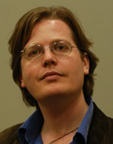
An interview with Noah Wardrip-Fruin
Noah Wardrip-Fruin is a digital media writer, artist, and scholar. His writing/art work creates new experiences of reading through bodily interaction, algorithmic recombination, and exploration of the potential of the network as more than a delivery mechanism. This work has been presented by galleries, arts festivals, scientific conferences, DVD magazines, and the Whitney and Guggenheim museums. As a scholar he has recently edited two books: The New Media Reader (2003, with Nick Montfort) and First Person: New Media as Story, Performance, and Game (2004, with Pat Harrigan), both from MIT Press. Wardrip-Fruin has taught writing for digital media in Brown University's Literary Arts program, New York University's Graduate Film and Television program, and the Summer Literary Seminars of Saint Petersburg, Russia.
His work is discussed in Information Arts (2002), Digital Art (2003), and Art of the Digital Age (forthcoming) - as well as in The Guardian, The New York Times, Technology Review, BBC News, Wired News, and U.S. public radio stories. Wardrip-Fruin grew up largely in California, in the cities of Palo Alto and Long Beach, though his family also spent time in Japan and Boston. He attended Long Beach Polytechnic High School, where his contemporaries included rapper Snoop Dogg, and graduated in 1990. After college, Wardrip-Fruin moved to New York City, where he was an artist in residence and then a research scientist at the New York University Center for Advanced Technology and Media Research Laboratory (1994-2001). At NYU he collaborated with computer graphics pioneer Ken Perlin on the design of next-generation interfaces and received an MA from NYU's Gallatin School, 2000. After NYU he became a professor at the University of Baltimore, where he collaborated with Stuart Moulthrop and Nancy Kaplan on the design of the curriculum for the newly-launched School of Information Arts and Technologies. From Baltimore he moved to Brown University, where he works with Robert Coover and others on exploring the literary potential of digital media (especially the immersive virtual reality "Cave"). He is currently a Teaching Fellow at Brown University, where this interview took place on April, 2005. We talked about Games, Language, Digital Literature and the Future of the Game theory.
Cicero Inacio da Silva* interviewed him.
Cicero Inacio da Silva: You have recently edited a book (First Person) on new media, story and games. Why are you interested in games?
Noah Wardrip-Fruin: For a couple reasons. I think that -- on a fundamental level -- playing games, performing for each other, and sharing stories and poems are deep human activities. All these activities have come to digital media, in one way or another, and I wanted to create a book where people who were thinking about all of these would be in one context, and could actually respond to each other -- so we can start to, through that dialog, think about the field in a broader way. This is part of the motivation. But another motivation was that, although I think this is changing, there was a sense that games were a kind of the Other, the separate thing in digital media. Games were very successful commercially, but very uninteresting from an artistic point of view, from a scholarly point of view. So I also wanted to challenge that a little bit and say: "Yes, games are one of the most popular forms of digital media, but they are also interesting art work, interesting writing, interesting design, and I think that scholars and artists have to contribute to our discussion about making and criticizing games."
CIS: What do you think about the relationship between games and literature?
NWF: There are three relationships that I want to think about. One is the relationship between games and the traditional literature. So, someone like Warren Motte, who has written a book called Playtexts (from the University of Nebraska Press), talks about writers, from the surrealists to the OULIPO, and many others groups, who used play as a way of thinking about their writing process, who used play as a way of thinking about the reading process that they wanted, how the audience can go through the text and engage with the text. That is one of the relationships that I want to think about. Another is that some early computer games were very textual, and some pieces were quite literary; others were graphical, and maybe literary in some structure, but not in the language that they contained. And what happened after that was that our ability to deal with language computationally didn't develop as quickly as our ability to deal with graphics. In the 1970’s and in the early 1980’s we tried to deal with language computationally using ruled-based artificial intelligence techniques, and that ruled-based artificial intelligence…
CIS: You mean an algorithmic process to produce a text or work…
NWF: Yes, right… I'm talking about processes for recognizing and producing natural language. At the moment we have techniques that work very well using statistical techniques, operating with large bodies of language. We use the patterns that we see in these large bodies of language to try to interpret and produce language, and that is more successful. In the 70’s and in the 80’s, we used ruled-based techniques, and we got some results, but could not go further. At the same time, computer graphics took off. Computer graphics driven by military applications, driven by Hollywood, and now driven by computer games, got better and better. So computer games, maybe for that reason, maybe for others, became more and more focused on graphics, and there wasn't much to say about that in terms of literature. Now, I think that is changing. Computer game companies are hiring full-time writers. They are hiring writers who have experience, who think and write through and for procedures. At the same time, our ability to deal with language, computationally and algorithmically, is getting better. So, the second issue to think about is how these things may be producing a new kind of literature, connected to the field of computer games. Now, most computer games are becoming better written, but often toward the goal of being like Hollywood blockbusters. However, I think there is a growing alternative game movement. And the alternative game movement may produce work as well written as good plays or good movies, instead of as the bad movies. The third interesting relationship is thinking about how literary structures may be important to games that it doesn't make sense to think of as literature. An example is quest structures. Espen Aarseth has written about this. Janet Murray has written about this. We don’t want to think about all computer games as literature, but we can better understand some of the structures by using literary models.
CIS: Actually, my third question has something to do with your answer… how do you see the game market with this explosion of these new game technologies, and with the big media companies (like Disney, Warner, etc.) getting inside this field?
NWF: Well, in the US we had our first big boom in games in the early 1980’s, and people like Warner did get involved; they did things like buy game companies. And this was huge in the US, because people were playing so many games… and then came the big bust. The computer game industry entered in a kind of collapse. Some people have interpreted that collapse, in part, as having to do with the intrusion of the big media companies. This leads to people saying: “Big media companies don’t understand games,” and so on. I don’t know if I believe that. It's hard to believe that big media companies categorically can’t understand games. But it is true that, right now, the big games companies are people like Electronic Arts, and people like Microsoft, although also people like Sony, and Sony does have a significant presence in other kinds of media. It'll be interesting to see how these big companies play out. All that said, I think right now most computer games are produced on the model of big media, where we have a big studio that spends a lot of money and takes a big risk trying to create blockbusters hits. And everything that is not a blockbuster hit is a kind of failure. We need to change that. I think computer games are only going to grow as an art form when they become much more diverse that they are now, in terms of their models of production.
CIS: Do you think that this “games invasion” is a fashion, or up-to-date, like the TV in the 50’s and the internet in the 90’s?
NWF: Well, I think TV in the 50’s and the Internet in the 90’s were marked by a struggle to understand something, and this is a struggle, probably momentary…
CIS: Let me situate my question: I think that the internet changed many points about our culture, and I think that, even today, we still cannot understand exactly what happen through the internet and on the internet. Now we have this game culture, which also uses the internet. Today, we still are thinking about what is the Internet, what kind of impact it has in our representations. I think that it is a great impact, it is something important…
NWF: Right. I am thinking that my mother has a laptop that she carries with her, not just when she travels, but she carries it around the house, you know…
CIS: My parents do the same...
NWF: Right. And when she is thinking about something, and she wants information about it, she opens her laptop and she does a web search. And, usually, the information she wants is right there. I think we haven’t finished thinking about what that means for our culture. For one thing, I think a large group of people assume that the online world is going to be like a library, with a lot of information available for free. That is very powerful, because the most powerful thing is what people take for granted, and what they take for granted is that the internet is a library, and if you try to change the internet and stop the internet from being a library they are going to say: “What?” They know that the internet is a library, and we can only see how that developed in retrospect. In the 1990’s we were saying: “What is the internet going to be? Is it going to be like cable television?” Now we know that for people like my Mother the internet is like a library (and email). We don’t know yet about computer games. We don’t know what sort of dominant models will develop, or if they will be like the current dominant models, or how they will challenge our expectations. But, certainly, for those in their 30’s and younger, we have a group of people who expect games to be part of daily life: not set apart in the arcade, but played on a console with a television; or played on a computer where they also do their work; or played on a device that they can keep in their pocket, like a Game Boy. So I think that it is taken for granted that games no longer are separate, and that will be, maybe, one change that we will start to see.
CIS: Yes, it was interesting when I was playing a certain game and, inside the game, I found I could go to the bank. It impressed me that while I play I am able to go to the bank, check my balance account, or transfer money to someone. In some cases, you can go to the supermarket and do some shopping. Also, we start to see a lot of ads inside the games...
CIS: What do you think about the critic view on VR, related to aspects like “reality” and “virtual”? Do you think that, with the VR, we are trying to build a new cave for our lives, as Plato pointed out, or that we are trying to understand how we are what we are? Do you agree with the point of view that we are outside Plato’s cave, and now why come back? We are already out, and there is nothing interesting outside, so now what?
NWF: (laughs…) If I remember Plato's cave correctly, there were chains, and we could only see shadows. OK, this is not the literal cave, and not the literal chains, either. So one thing that interested me about a lot of theories of virtual reality was the assumption that we could use VR to reproduce normal spaces, and to create impossible spaces. But I think that computer games are the closest thing that we have to popular Virtual Reality, even if it’s not stereo display. People move through virtual spaces a lot. Most of these virtual spaces operate by the same physics, as much as possible, as our reality, or contain structures as much as possible like buildings in our reality. It’s much more popular to play a game like Counter Strike than it is to play a game like an abstract shooter, where you can move through impossible spaces.
CIS: Like Doom...
NWF: No, let me think of a good example… I'm trying to remember the names of a couple of games made by a guy called The Yak, where what you do is fly. You fly in an abstract vehicle through abstract spaces that are made up with shapes and colors. And some are beautiful spaces, the kind of spaces that I think a lot of early Virtual Reality theorists imagined. And, of course, you are playing a game, and you blow up these beautiful things, and it makes great sounds when you move through it. But this is not as popular as shooting things in much more normal spaces. However, that said, we don’t really know what will become popular for a certain generation. It could be that when people who are now in their 30’s are in their 50’s they will want these impossible spaces. Or could be that they will want more and more realism, they will want The Sims. The Sims is about our everyday life, but maybe they will want even more reality: the people acting more like real people, the economy acting more like the economy. Who knows? It’s very hard for me to predict.
CIS: The representational aspect of the games is one of the most important points to discuss in game theories, because it implies in what somebody can do in a game: kill, explode, be a terrorist etc. And in the games we need a purpose or objective to continue playing, that always include kill, buy, sell or explode. Do you think it is possible to produce a game in witch an objective doesn’t exist? If it’s possible, what kind of game will it be?
NWF: First, I need to say that in some games, like Tetris, you don’t blow up anything and you can’t win. There is no objective about winning; the objective is only about not losing for as long as possible. I think this is kind of interesting, because we tend to think that Americans always want to win. And Americans love Tetris, Space Invaders and a lot of such games. Of course, you can have a high score -- maybe having a high score it the closest to wining -- but you always lose, and you need to keep from losing as long as you can. But, yes, I think that there are going to be, and maybe already are, digital media experiences that share a lot of traits in common with games, but have different kinds of goals and different kinds of actions that you take. But I’d say that if you don’t have game kinds of goals, probably we should not call the experiences games anymore. Maybe we should call them another kind of digital entertainment. So for example, do you know projects called Dogz, Catz, and Babyz? People like Andrew Stern and Adam Frank have worked on these projects, where you have just a little pet that lives on your computer and...
CIS: You published something about this in your book, I think in one of the discussions about an article…
NWF: Yes, in one discussion. Andrew Stern is one of the respondents in the book, and he talked about those projects. They are a kind of project in which you can explore your of relationship with the character, and I guess, from our point of view now, they might seem a bit primitive. You know, the graphics were simple, the artificial intelligence was simple, and who can imagine what will happen when things like this go further? Similarly, there are projects where the creators really focus on things like the story. Andrew Stern collaborates with Michael Mateas (who also has a piece in the book) on a project called Facade. In this project what you do is: you go over to have drinks with some people who you introduced and who are now married, and their marriage falls apart during your visit, but it falls apart differently, depending how you interact. It falls apart horribly, almost no matter what; there isn’t a way to win, there isn’t a score, and you don’t have to have a high score, but people play them. It’s not been publicly released, but I've played it, and replayed it, and a number of people that I know, who have received copies of it, are playing, and playing again, and playing again. Not because they want to do better, but just because they want to understand the space of possible stories. In some ways, it is a kind of postmodern fiction, which makes you think that the story can happen this way, or can happen that way, with much left to chance, and where you play the part of “chance.”
CIS: The game theory is nowadays exploring new theoretical interfaces, and some of them are narrative and literature. Some scholars are producing a lot of texts explaining the resources and the advantages of using games in the educational and pedagogical field, pointing out that games are easy and closer to their reality than books are. Do you agree with this point of view? What do you think of the critics that say that this student will be a person that just reacts to some specific actions, and that he or she will actually not think about it, or even elaborate some new point of view about his or her own situation? Or in other words, quoting Lyotard: “this is the perfect world to capitalism”. We will have just action and reaction. What do you think about this? How can we differentiate when somebody is responsive to a situation or when he or she is really thinking about a problem, even playing a game?
NWF: Well, one thing that we might have to think about is where the graphics technology for games comes from. A lot of funding is from military sources, and their aim was to create flight simulators and battle simulators. The reason the military put a lot of money into developing things like flight simulators is not because they thought that books are bad, but because maybe there were things that you can learn from the simulation, but you can’t learn from the book, or that are very hard to learn from the book. For them, these flight simulators were not an alternative to giving someone a book about flying, but were an alternative to actually putting someone in a cockpit of an airplane, an alternative to real world action. I think, in some ways, that what we need to think about is the goal of games in education. And the goal of games in education probably should not have to be trying to teach things that we can learn from books, but to teach things that we can’t teach with a book. And to teach things like these we might be able to simulate things that we can do in the real world, or things that we can’t do at all. People try to do this, for example, using games like SimCity to teach kids about cities. But there we run into another problem: Sim City does not come from nowhere, it is based on a research by an MIT guy called Jay Forester. Forester did a lot of work trying to understand urban planning through simulation, but his cities were very distorted cities -- for example, his cities have no suburbs, so we have children…
CIS: I also think that he never saw a “favela” in Brazil…
NWF: Yes, and if you have children trying to learn how to understand cities, and trying to learn how to understand cities through a simulation, that simulation will be always authored by people, and will always encode some of the ideological assumptions of those people. Part of what we try to do in education is to help students to develop a critical view of what they read in books; not just learning information, but also learning to think about what is not there, what the author doesn't say. What we now need to consider, in thinking about children learning through simulation, is how to develop a critical view of what they learn from the simulation, how they can understand the rules that make the simulation operate, and what are the limits and the blind spots of these rules. How children can develop that is a very tricky question; if they don’t develop that, then they are just reacting, they are just doing that simulation in a way that we don’t like. And the answer, maybe, is the same that we had from written literature, where people, or part of the people, achieve a critical view of what they read, and then they learn to write, and they learn about the writing process, and how with the writing process all these things came out. Maybe children will have to learn to author simulations, before they will be able to understand the relations, limits, and ideological field of games, and are able to be critical about simulations.
CIS: What do you think about the images in the games, aesthetically speaking? I mean, in 90% of the games we have, more and more, an exact reproduction of what we call reality. In the Renaissance, we have the same thing, and now, after Walter Benjamin, after Susan Sontag, after all the critics of the metaphor and representation, we are producing again the same reproduction of reality. Why do you think that we are doing this, if the computer can create images without any relation, or need, to capture this named reality?
NWF: One of my favorite phrases from a game theorist named Eric Zimmerman (and he has a lot of pithy phrases) is: “Cinema Envy”. He says that a lot of the game industry is caught up in “Cinema Envy”, and in part because cinema is taken seriously as an art form. But a lot of it is just because they like films, and because games right now can’t reproduce the cinematic experience, and because cinema is seen as desirable, and because you can be lauded as a computer graphics researcher for producing something more realistic. I think there are a lot of forces that drive games to increased cinematic realism, and, at some point, that will exhaust itself. I think, at some point, you will be able to, in real time, in response to what the users have done, produce something that is not distinguishable from a videotape, as good as the quality that you can get from your television. We’ll probably have to go that far before non-realistic rendering really begins to take hold. Right now, there are occasional games like Viewtiful Joe, done in cartoon style, where the imagery is really trying to reflect the content of the game in a non-cinematic way. But, right now, almost all the work that is trying to reflect the content of the game visually is drawing from cinema. Games like Max Payne are trying to look like a noire movie. They are not trying to invent a new way of looking, that only will be possible with the computer. Having said that, I think that we need to remember that movies are starting to be influenced by computer games. Maybe there is a new aesthetic form emerging from that as well. All that said, personally my interest in games is not usually driven by what the game looks like, and I agree with those critics who say that, regarding most serious players of games, they are looking through the imagery to the play. Eventually, what the game looks like becomes only a way of understanding the way that the system works. Games have a meaning in terms of play, and not only in terms of what happens visually; most games are about accomplishing something in terms of rules and goals, and those are not visual. On the other hand, I'm reminded that Peter Molyneux’s game studio is working on a game called “The Movies”, and the result of play is to produce trailers and snippets for movies, so your game goal is actually a visual goal, and those visuals try to have a style, but again it is a style based on movies, so who knows…
CIS: Do you think it’s possible that in the future a “game critic” will write about a game in an analytical and critical (scholarly) sense? I’m asking this because I think that the majority of the critics of Game Theories and digital narratives doesn’t quote or sometimes even know authors or important discussions about literature and literary criticism, and we know that this field had produced a lot of discussions about narrative, form, meaning, representation, reality, and one of the most important: ideology. Do you agree with this point of view? I think that some points of Digital Literature, and the use of the name “literature” itself, sound to me sometimes just as an attempt to give more credibility to this “digital” field, and what I see is a few authors discussing criticism, related to these “digital” topics of writing.
NWF: I think that one useful thing to do is to look at something called the “Scandinavian School” of games scholarship. Part of the reason is that this Scandinavian School -- and I am talking about people like Markku Eskelinen, Espen Aarseth, and Jesper Juul -- so these people, many of them are deeply engaged with contemporary literary criticism. They are very aware, and a number have backgrounds as literary scholars, so they know the history of literary criticism. And yet the work that they are doing is seen by some literary scholars as very naive, because their work is often quite formalist, trying to talk about the formal characteristics of games, or how you understand the passage of time in a game, and so on. People say: “We have been through this phase in critical history”. But their point of view is: “No, we haven’t been through this. We have been through this in literature, we have been through it for films, but we have to go through it again for games”. Because games are fundamentally different. And only once we go trough this period of formalism can we begin to take that formalism apart and expose its limits, and talk about the blind spots of the earlier generation -- but there has to be a first generation. Some people disagree, and they may also come from a literary background. Let’s say the Georgia Tech group -- people like Janet Murray, Ian Bogost, Michael Mateas, and Jay Bolter -- who have significantly less interest in formalism than the group I associate with Scandinavia, though also work on projects with names like "game ontology." Henry Jenkins -- who doesn’t come from a literary background, but from a media studies background -- in the First Person book talks about the Scandinavian Vikings versus the North American Eagles. There's some perception of conflict, but also a humorous attitude toward it. And we shouldn't forget people like Gonzalo Frasca, Nick Montfort, Stuart Moulthrop, and others who can't be put in a camp (or the fact that Gonzalo's been both at ITU Copenhagen and Georgia Tech). I guess I would say that, personally, I find a lot of valuable work in both groups. I think neither group is ready to have games just talked about in terms of current literary theory. I think that both groups agree that we need to develop some new perspectives to understand that games are procedural and interactive. If we don’t understand those things, and just apply perspectives from literary studies, we will misunderstand this experience. But I think we'll make progress. And just the same way every major university has cinema scholarship, I have no doubt that we will not have any serious university without game scholarship.
CIS: …and now, a hard question: do you play games? What is your favorite?
NWF: (laughs…) Yes, I play games, and playing games is like reading: it takes a lot of time. I mean, you're never caught up, you always need to do more than you have done. I think that is one of the advantages that cinema scholars have over us. You know, they take two hours to watch a movie. And you take so many hours to play a game, and to interact in a complex novel. You can go and survey the work of a major director in a week -- and if you go through a series of works by a major game company it'll take many times that. Anyway, my first experiences with games were with things like the Infocom games, like Zork, and maybe earlier things like Hunt the Wumpus. Then, when I was in high school, I played a lot of Tetris, and we had a Nintendo game console. I'm also passable at arcade games like Ms. Pac-Man and Centipede and Pole Position. Right now, I would say I've gotten to the point that my favorite things are experimental. So I really enjoy things like Façade, though I also enjoy playing blockbusters like Fable. But in some level, it’s not the same; the people who are doing Fable have an obligation to their funders to create something that will appeal to a really wide audience. And things with such appeal, not meant for a narrow audience, don't grab me in the same way.
CIS: Thank you and I hope that you can come to Brazil as soon as possible to work with us in future projects, and maybe develop a scholarship in the game field.
*Cicero Inacio da Silva is a Visiting Scholar, Brown University (Spring Term 2005) with a Fellowship supported by the Foundation for the Coordination of Higher Education and Graduate Training (CAPES/MEC/Brazil). Assistant Professor, Catholic University of Sao Paulo.
Links:
Warren Motte: http://www.colorado.edu/FRIT/profiles/motte.html
OULIPO (Cent mille milliards de poèmes: http://x42.com/active/queneau.html e Raymond Queneau: http://www.queneau.net)
Espen Aarseth: http://www.hf.uib.no/hi/espen/
Janet Murray: http://www.lcc.gatech.edu/~murray/
Electronic Arts: http://www.ea.com/
The Sims: http://thesims.ea.com/index_flash.php
Tetris: http://www.neave.com/games/tetris/
Dogs, cats and babies: http://www.quvu.net/interactivestory.net/papers/stern_emotionartifacts1999.html
Facade: http://www.quvu.net/interactivestory.net/
SimCity: http://simcity.ea.com/
Viewtiful Joe: http://www.capcom.com/vj/
Max Payne: http://www.rockstargames.com/maxpayne/
The Movies: http://www.lionhead.com/themovies/index.html
Markku Eskelinen: http://www.dichtung-digital.com/2004/3-Eskelinen.htm
Hunt the Wumpus: http://www.wurb.com/if/game/442
Infocom games: http://infocom.elsewhere.org/
Zork: http://www.csd.uwo.ca/Infocom/zork1.html
Gonzalo Frasca: http://ludology.org/staticpages/index.php?page=20030129004146960
Jesper Juul: http://www.jesperjuul.net/
Ian Bogost: http://www.lcc.gatech.edu/~bogost/
Michael Mateas: http://www-2.cs.cmu.edu/~michaelm/
Henry Jenkins: http://web.mit.edu/21fms/www/faculty/henry3/
Peter Molyneux: http://pc.gamespy.com/pc/the-movies/513182p1.html?fromint=1
The Yak: http://www.llamasoft.co.uk/jeff.php
Posted by jo at 05:01 PM | Comments (0)
Single Story Building
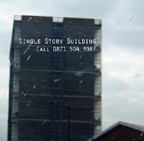
Mocking Interactivity
As part of Tate Online’s 40 artists, 40 days – a project in support of London’s Olympic and Paralympic Bid to bring the Games to Britain in 2012, Blast Theory is presenting a new phone based work: Single Story Building. In this interactive work, the participant drills through two thousand either/or questions. Starting with the question ‘Urban or Rural?’, the piece moves from the expansive into the cloistered, finally arriving at a secret and private space. Reminiscent of ‘10×10’ by Charles and Ray Eames, it uses this swoop in scale to explore the taste of the participant, whilst gently mocking the notion of interactivity itself.
Single Story Building can be accessed anytime of day by phoning 0871 504 3987. Use your phone's keypad to navigate through the work. Calls are charged at the national rate (8p/min from a landline). [blogged by Regine on we-make-money-not]
Posted by jo at 04:36 PM | Comments (0)
John "J.Walt" Adamczyk
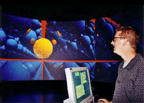
Live Animation Performances
Graphic performances are animated paintings and sequences created live in real time. John "J.Walt" Adamczyk utilizes the latest in interactive computer graphics techniques to bring paintings to life. The result is a Spontaneous Fantasia, a visual music that unfolds before an audience. These works incorporate elements of animation, theater, dance, painting, sculpture, music, architecture, and interactive art.
With my graphic performances, I take literally the meaning of the word "animation": making images come to life. I use my drawing skills to give directions to computer programs I've written. I aim to capture the sensitivity of gesture, but I also use techniques which amplify and augment the gestures. The wave of the arm or the stroke of the pen is still there, but the effect is much more. My creative process for these pieces is to continually shift between painting, programming, composing music, and performing. I practice each piece until I am satisfied that I can perform with ease. At that point, the computer interfaces and the program are like a musical instrument.
Posted by jo at 08:37 AM | Comments (0)
Dream Catcher
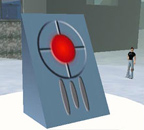
Do Avatars Dream?
Dream Catcher, by Milan Prucha, investigates the blurring of boundaries between 3D online games players and virtual life experiences.
The project is a dream recording and sharing service for Second Life avatars. The service can only be accessed by avatars (via specially designed dream recorders) from within the Second Life world. Although the work exists in a virtual and intangible space, the service itself (running live within Second Life) is real. Real people control the avatars, and hence the dreams that the service receives are the dreams of real people from all over the globe. [blogged by Regine on we-make-money-not]
Posted by jo at 08:24 AM | Comments (0)
The Lonely Home Bench
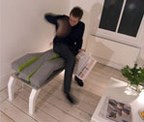
Bench Pet
The LonelyHome bench, by Tobi Schneidler and m.a.o.works, is a "socially intelligent design object", part domestic furniture and part robotic pet. You can use it as a normal bench but it will come alive unexpectely to confront you and challenge your presence. It might, for example, try to throw you off when you sit down and moves when you stroke it.
The LonelyHome is a relative of the The RemoteHome, an apartment that exists in two cities at the same time and connects close friends over distance through tangible design elements. Video. The LonelyHome bench is at Victoria & Albert Museum, London, until August 29th 2005, as part of the Touch Me exhibition. [blogged by Regine on we-make-money-not]
Posted by jo at 08:17 AM | Comments (0)

